The Remington Portable Model 5
Sunday, August 31, 2008

When my grandmother Lolita was in New York, before she returned to Manila, sometime in the mid 1930s, with my mother Filomena, and brother Tony and sister Dolly she purchased a Remington Portable Model 5 at the American Writing Machine Company. This portable traveled the world and by the time my abuelita arrived in Buenos Aires in 1939 with her children, now adults, in tow she had the machine adapted to the Spanish keyboard with an ¡, ¿, ñ,ü and the accent to the right. Whenever the machine was taken out of the closet by either my grandmother or my mother I knew something serious was afoot. They would type important letters for job applications or to fulfill some Argentine legal or bureaucratic requirement.
In 1958 I failed (the only one) typing in St. Ed's in Austin. I did learn the keyboard well but I could not write quickly without making mistakes. It was only around 1976 that seeing a TV ad in Vancouver I found out I was dyslexic. By 1964 taking notes in college had deteriorated my handwriting to the point that not only my teachers but I could no longer read it. In 2008 I can no longer sign my name and make all the letters legible. I simply had to type to communicate. The Remington became my baby and caused me all sorts of frustration as the floor around me when I typed was full of sheets and sheets of rumpled attempts to typing a whole page without making mistakes.
This frustration lasted until 1990 when I purchased a Smith Corona PWP-40 which was an early version of a portable word processor that did not have the complexity of a computer or any association with that even more complex "thing" called Word Perfect. When I finally broke down and obtained a computer around 1994 I refused to use Word Perfect and posted stories and articles to the Vancouver Sun by writing them in the email program that I used at the time, Eudora. My editor at the time, Nick Rebalski had no problem as at the time there was an incompatibility between the PC based Word Perfect and whatever they used at the Sun.
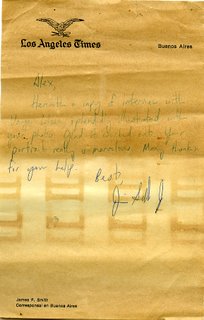
By 1986 the Remington went back to a closet but I took it out around 1995 and placed it for display on a table in our living room. As some sort of an irony I slipped a handwritten note from the Los Angeles Times Buenos Aires correspondent, James F. Smith into the machine's carriage. I had met Smith in Lima in 1990. We were both there to interview writer Mario Vargas Llosa who was running for president. Some months later the Times used my portrait and Smith had sent me the thank you note.
When I got my first scanner some 5 years ago I needed a table by my computer (on my desk in the living room). I used the table the Remington was on so my grandmother's machine went back to the closet. I took it out a few weeks ago to photograph Ms. Hernandez as an evangelista.
The Remington is back in the closet and I feel sadness. The presence of my grandmother and mother are there when I stare at the keys. The old black fabric covered case smells of age and propels me to remembering the noise I would hear when they would open the case and then type with what then was called a noiseless wonder.
I remember being in Buenos Aires in 1966 and watching with amazement as my secretary Edna Gahan could somehow decipher my handwritten translations and type them with her then state-of-the-art IBM Selectric. It was as much a marvel as was my Schick razor which had one long and contiunuous blade that I would advance to a new section when the previous one grew dull.
Now I would sell my soul to keep Word and that ever so useful tool, word count.
Frances Bula, Miro Cernetig, David Baines, Ian Mulgrew & Malcolm Parry
Saturday, August 30, 2008

It was in August 1978 that I had my first real (I had others but this one counts for me) cover in Vancouver. It was most fun to work with Valerie Gibson who with a few nudges from then Vancouver Magazine editor, Malcolm Parry, pioneered gossip writing in our city. Gibson truly believed in the importance of what she did and she called the people she wrote about "my people". For a few years she would drag me to upper crust parties to photograph her people. "I like having you along because I don't have to tell you whom to photograph. You know." And of course Malcolm Parry (and a host of imitators) now do double-duty as gossipers and photographers. I would state that Parry is a cut above the others in stature, both figuratively and literally. It was Parry and art director Rick Staehling that really helped me launch my career as a magazine photographer. While I may have had covers in international publications I will never forget this one which is clost to my heart. And it was also Parry,a Vancouver Magazine political and architecture writer Sean Rossiter who nurtured my interest in civic affairs.
But coincidentally it is this cover, shot so many years ago this month, that has been in my mind as I notice how I react to magazines, internationally, nationally and locally. More than anything I have been noticing how my circle of friends (going the way of entropy) has lost interest in discussions with me on local media.
None seemed to be interested in trying to figure out why Vancouver Sun political columnist, Frances Bula, bolted to Vancouver Magazine. Is there a way that magazine could possibly pay her and give her all the social services she got as a Sun writer? Will she be able to do her investigative reporting with those much longer magazine lead times?
I have often wondered why one of my favourite Vancouver Sun columnists, Ian Mulgrew is wasted (my opinion) reporting on crime when he would do a better job in reporting about our true criminals, the politicians. In the same way David Baines's untouchable sense of ethics would also be excitingly used in politics. The latter example would be what CBC movie reviewer Rick Staehling would call cross casting.
Few of my friends noticed the Vancouver Sun Miro Cernetic column a few months back where he stated (most accurately) that Premier Gordon Campbell was our de facto Mayor.
Years back Malcom Parry often ran incisive articles on how things were at the local newspapers. I enjoyed them. I even remember Sun writer, Rick Ouston somehow writing some of those. I always admired Ouston's equally (like Baines) unimpeachable ethics and honesty.
I wonder these days if the people on the street even care who writes what in what column in whatever paper or magazine you might cite. Many will mention the ascendance of local blogs. Yet if you go to some of the mayor local blog aggregators like Vancouver I Am the bulk of the blogs are extremely boring rehashing of stuff you can read by the local reporters of our Vancouver Sun, Province, Georgia Straight and the Courier. And these articles are infinitely better written. A great majority of the blogs are about popular music and food. Is this the stuff that makes our city the city it is? Perhaps. But isn't there more?
And as fewer and fewer of my friends have any interest in our city's civic affairs I wonder if there is something wrong with me.
If only I could go back in time and pinch Mac Parry (as he was then called) and bring him to 2008 (minus a digital camera) and tell him, "Start something that will tell me a bit more about the city we live in. And as you once said to me, "I don't want to see more perfect pictures of perfect houses without people in them. ""
I cite the above Vancouver Sun columnists and ex-columnists for a reason. In spite of the recent articles predicting the diminishing influence and the shaky financial status of the Vancouver Sun I believe that its forthcoming demise may be greatly exaggerated. If they could only find their way.
VLM, Crystal Pite & Her Hugo Boss Shoes
Friday, August 29, 2008
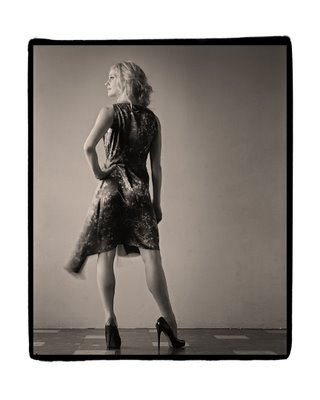
The two pictures that you see here happened because of the perseverance of stylist Maureen Willick. I was given the assignment by VLM Editor/Publisher/Art Director (take that all you local Editors-in-Chief!) to pick about 9 people in Vancouver related to the arts. The article was to be called Who's running the show? To justify 8 pages of editorial the article was also to be a fashion spread. So that's where Maureen Willick came in. Mercer knows I call her "my secret weapon" so he indicated she be brought on board for the project.
Willick insisted I photograph modern dancer Crystal Pite, Director of the local dance company Kidd Pivot with a pair of Hugo Boss shoes and to take the picture from head to toe. I am loathe to this sort of thing. I am a portrait photographer. A head to toe photograph makes the face smaller. It is simply not my style. But she insisted and insisted until I gave up. The temperature in my studio was around 28. I had a couple of small fans going to circulate the air. But I noticed that Pite's silk Obaki dress was fluttering and in some cases the dress was sticking to her extremely fit and shapely body. Something which was later observed by Mercer.
By some sort of coincidence Pite had commented on the wonderful light coming in through the windows of my Robson Street studio. The light is reflected from Cesar Pelli's. Eaton's turned Sears. I have made it a rule to ignore that wonderful light when I can control my own artificial light. But I listened to Pite and tried to please her as much as I finally tried to please Willick.
Because I was using existing light and an inherently slow film (Kodak Plus-X ISO 100) I calculated that my exposure was f-11 at 1/2 second. That meant that the slow shutter was sure to blur the dress. I placed my medium format Mamiya RB-67ProSD on a very low tripod so that there would be no camera shake. I knew that Pite, the professional dancer that she is could stand without moving a limb while her dress fluttered. The result was a pair of photographs that Mercer so loved that he used both for the opening spread of this month's VLM.
I must not take any credit for this. Mercer saw the photos for what they were, extremely appealing and elegant images of a multi talented Vancouver prodigy. A real person, she is, too. He should be thankful to Maureen Willick (my secret weapon) for insisting on the shoes and to Pite for recognizing the quality of my studio's window light.
I will not take any credit except to point out that at the very least I was smart enough to ask her in the end why she liked the shoes. She said it and I recorded it. I forgot it. Then I transcribed the conversation. This was her answer. I think it is as perfect a sentence as a sentence can be.

I love wearing these shoes because they are impossible and I have to find stillness in order to remain upright."
VLM gainfully employs me and provides me with space to pretty well photograph whom I want and to write what I want. I would like this to continue against all odds. You can help by following the step below:
Have you subscribed yet? For a FREE
subscription to VLM log onto vlmag.ca
-----
Bob Mercer,
Publisher / Editor / Art Director
VLM: Vancouver’s Lifestyle Magazine
[email protected] / 604-630-1121
400-73 Water St., Vancouver, B.C. V6B 1A1
New Web Address
The Flappers
Thursday, August 28, 2008
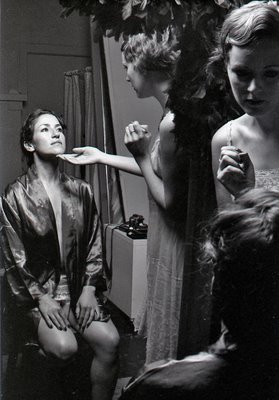
Yesterday Ms Hernandez and Cordelia placed themselves in front of my Ikea mirror and I told them, "One of you is a flapper and you have the body of one. The other will have to be bound in certain places to look like one. Go at it." This they did. Here is one of the initial pictures before the final transformation. The picture has it flaws. You can see my metal table on wheels with some of my equipment. I was not noticing the details. But then I was shooting this with my large camera while also using the smaller and more maneouverable Nikon FM-2. No matter how careful I placed my light over the mirror I got flare in my lens. I don't have assistants who could have flagged my camera. I should have clamped a flag near my camera to avoid it.
But this picture still has its charms. Somehow the light bent a bit and spilled over the darkened Cordelia so that there are two almost clear images of her. In a world full of pornography the three of us decided that we would find some way of showing two women together with class and good taste. I hate that word, tasteful. But here class and good taste come courtesy of Ms Hernandez and Cordelia who have it in spades.
In days to come I might post some more from this series or perhaps from another that we worked on in the same day. It involved dressing up one of them in my Puerto de Liverpool suit. The pants fit Cordelia much better than they ever did me. And Ms Hernandes, El Evangelista supreme looked wonderful again in that Fraser Institute tie.
The above mention or link to the Fraser Institute does not in any way mean I happen to endorse the institute's policies, it is much to the contrary.
Clemen From Tierra Blanca, Guanajuato & Now On Bowen
Wednesday, August 27, 2008
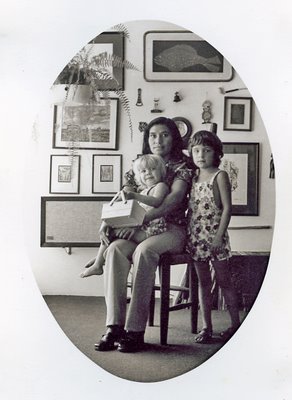
In 1973 Rosemary and I were so busy teaching (in Mexico City) that we had no way of taking care of our daughters Ale (5) and Hilary (2). My mother had died and we had no baby sitter. So we hired Clemen Valdez to be our housekeeper and baby sitter. She was especially sweet and patient with Hilary who was a terrible baby. The only way she would drink her milk was with Chocomilk (a very sweet instant chocolate powder). Clemen was from the interior of Mexico, from the state of Guanajuato. Her town's name was Tierra Blanca.
By 1975 we had made the decision to leave an uncertain Mexico (both politically and economically). We told Clemen that we were going to do our best to bring her with us. Somehow that did not work out but by some miracle Clemen appeared in Vancouver in 1976 and Rosemary does not rembember the paper work that had been involved.
The situation in Vancouver was no different from Mexico City. Dave Barrett and the NDP lost and we soon had no baby sitting facilities in Burnaby. Clemen was our babysitting ticket and our cook while Rosemary and I worked. By 1979 Clemen was gone to better wages in West Vancouver.
But during her stay with us she managed to keep Spanish in our household alive. To this day both Ale and Hilary speak Spanish fluently. We also got used to the best Mexican food anywhere in Vancouver. It was at home as Clemen made tortillas from scratch. We especially liked her sopes ("deep dish" shaped tortillas) with beans and chicken or meat. My friends were always curious about the woman who answered our phone with an accent, "Bueno!"
Clemen had two other remarkable talents. Anything she planted in our small garden plot grew. And, unlike Rosemary, she could make me a decent cup of tea. I kept telling Rosemary that she could learn from Clemen to brew tea. One day I caught her re-heating (and boiling) that morning's tea. But somehow she could even do this and I had not known.
Rosemary decided that Clemen had to go home to see her family so she dispatched her with Hilary who was 7 and Ale who was 10. They flew to Mexico City and took a bus to Querétaro. From Querétaro they took a second class bus to a small town where Clemen hired a burro and the three went for a half-day treck to her home. Ale had eaten a sticky sweet Gansito (a sort of sweet confection wrapped in cellophane) before the treck and was quite sick. She could not walk so Clemen put her on the burro. this made it worse as it seems that riding a burro is no different from riding a camel and Ale got seasick. At Clemen's home, Clemen's father whispered into her ear, "You must take care of these two girls as if they were our own and then some."
Our story winds down to note that Clemen got married to man, Mike, from Bowen Island and she lives in a large property adjacent to a lake in the middle of the island. She has two grown-up sons Kirk and Todd. Both are avid mountainbikers. One of them was suspended for many days from school for cycling off the school's roof and then maneuvering down the front steps of the school.
Clemen has goats, turkeys, chickens (that lay eggs of every imaginable colour) exotic geese. She sells to the islanders her produce, fruit and it seems that Greek restaurants like her goats.

We visit her every now and then as we did a few weeks ago. Ale, who lives in Lillooet was not able to go. But in this picture here you can see Clemen with Lauren on her lap, Hilary (on the left) and Rebecca (on the right). Clemen says that Lauren is exactly like her mother Hilary and has a special affinity for her. Both Lauren and Rebecca watch Clemen make tortillas and love to get some right out of the comal (the hot flat skillet on which she cooks and heats her tortillas). They love staring at the goats.
Clemen can now speak English quite well (with an accent) but I believe it must be a special treat for her to talk to us in her language. It is something I will never take for granted the fact that 34 years later here we all are under a tree in Bowen Island. Who would have known back then in Arboledas, Estado de México?
The Solid Aluminum Presence Of Robert L. Grassby
Tuesday, August 26, 2008

Robert L. Grassby came into Tilden Rent-a-Car on Alberni Street in 1975 and asked for a Ford station wagon. When he returned the car a few days later he gave me his card and told me, "If you ever need my help give me a call." I have no idea why the man had been so pleasant with me. I do recall he was tall and he looked both intelligent and prosperous. He seemed the epitome of the modern upwardly mobile executive. I never saw him again but I kept his card because I thought it unusual. It was made of solid aluminum.
Since Rosemary is now at home she is trying to keep our unnecessary costs down. She wants me to get into a cheaper plan with my cellular phone. The phone is efficient but ancient and I use it purely as a phone. I have no call forwarding or caller ID and I would not think of using it for text messaging. "Surely, " Rosemary told me, "You can pay less if you don't have any extra features. A pleasant French Canadian from Telus (after being on hold in a priority mode for about an hour) told me the easiest way to save money was to register the numbers I used the most into a plan that would make calls to those numbers unlimited and or free. Rosemary checked and told me what I already knew. I call home, Hillary (Rebecca and Lauren's mother) and my friend Paul's cellular number. My calls to friend Ian Bateson and John Lekich I make from home so I don't go into expensive extra minutes with them.
It dawned on me today(I had the suspicion) that my world, my social and business world is shrinking. My friend Ian McGuffie would simply say it is entropy at work and soon my life as well as that of my friends' will grind to a halt.
It wasn't always like this. Back in 2002 the year began with such a bang of work and activity that I never transfered my contacts and phone numbers from the old 2001 Graphic Image agenda to the new one. So for most of 2002 I went around with two of them. I used the old one for the phone numbers and the new one to write down my appointments. Rosemary has told me that soon enough the year 2002 will be identical to a future date and I will be able to use the agenda again. I don't think so.
Looking into the phone number section of my 2008 Graphic Image agenda I noticed that I have fewer phone numbers listed and many that are I no longer call. My friends Nora Patrich and Juan Manuel Sanchez have gone to Argentina. The design firms I used to have a work relationship with no longer call me and mainly use stock imagery. Vancouver Magazine will not give me work as the art director holds some grudge. And the list of diminishing contacts diminishes!
My friend Grant Simmons shocked me this morning. I was complaining to him about the increasing mediocrity of my working relationships with magazines and how it was getting me down. He said, "You stay here because of your daughters and your grandchildren. When Rebecca no longer wants to visit you, when her boyfriends become important, what will keep you in the city? Does not Mexico beckon?"
I am currently working on my personal project called Mexican nostalgia. I find that there is nobody I know who would be remotely interested in my nostalgia of Lady Windermere's Fan (an Oscar Wilde play). I saw the play in Spanish in Mexico City in 1959 and Lady Windermere was the great Mexican actress Dolores Del Río. I will be taking pictures of Ms Hernandez with her hair up while holding my great grandmother's fan. Most of the people I know don't have a clue as to who Dolores Del Río is.
I asked Rosemary, "Do you feel we are isolated?" While Rosemary is a lot less social than I am she still answered that indeed she did feel we were isolated.
As entropy takes control of my life and I remember emptying my rolodex into our fireplace a few years ago, I find it somehow comforting that something of my former life remains, and that is the modern and dynamic Robert L. Grassby's solid aluminum card.
I'm Not August In August But I Try
Monday, August 25, 2008
retrato.
(Del lat. retractus).
1. m. Pintura o efigie principalmente de una persona.
2. m. Descripción de la figura o carácter, o sea, de las cualidades físicas o morales de una persona.
3. m. Aquello que se asemeja mucho a una persona o cosa.
Real Academia Española © Todos los derechos reservados

A cat retracts its claws. That verb retract comes from the Latin retractus and it means to pull back, to retreat, to disavow and to take back. I have often wondered how the Spanish word for portrait, retrato, can come from that Latin word retractus. The aspect of retreat or pull back could have something to do with the peeling of layers of a person's barriers until one is able to look at the person as the person is. Or as I sometimes say with the usual cliché, look into that person's soul.
I have always prided myself in my ability to take portraits. I rarely justify portraits with no eye contact. I get away with it when I photograph a dreamer. A dreamer can be a poet and sometimes a musician, actor or playwright. But I would never photograph a politician as a dreamer. We want to trust a politician. We want to look into a politician's eyes. The same "rule" applies to business folk although in the 60s and 70s BC Hydro CEO's could dream away in profile when we saw the rosy future of energy and technology.
Since I started taking serious pictures of Rebecca some 7 years ago I have been lambasted by my relatives who cannot understand why I don't take her picture smiling. As soon as I ask Rebecca to pose for my camera she gets this look that has fascinated me for so long. Why would I want her to smile? Why is it so important that people smile for the camera?

My favourite portrait photographer of all time (if I forget Philippe Halsman for a while) has always been the German August Sander who from the beginning of the 20th century until the early 60s took photographs of people mostly staring at the camera. He captured his subject's inherent humanity. Sander portrayed his respect for his subjects while at the same time drawing out of them a self respect for what they did and were, even if they were beggars. Sander's subjects almost never smiled and they never did things for the camera.
When I showed Rosemary my latest photograph of Rebecca by the fern (a fern that we have kept alive for 15 years) she said nothing. I insisted she say something and she explained that there was no expression on Rebecca's face. My daughter Ale (in Vancouver over the weekend) was kinder, "You are the artist, you understand, you see something which we perhaps cannot see."

Besides the very Mexican Ms Hernandez I have a new model whose salient features include a stare that can make you feel instant guilt, fear and even for this old man a rustling in the loins as Frank G. Slaughter would have written in one of his medical novels. Her name is Cordelia and you can see some pictures of her stare here. The staring gentleman is Irish film director Neil Jordan.
The Leonardo From León
Sunday, August 24, 2008

Sometime in the early 1920s my grandmother and mother were riding on the elevated train in NY City. They were sitting on either side of a man who had refused to move in the seat for three. My mother got the window seat. She asked my grandmother if she could see (in Spanish) and she answered (in Spanish), "I cannot because the man has a very large nose." The man looked at my grandmother and twisting his nose to one side said (in perfect Spanish), "Is this better?" They got off on the next stop.
My grandmother was a product of an 18th century Spanish education so she was antisemitic in what was the norm of the day for the Spaniards. People with big noses had "the map of Jerusalem on their face" my grandmother often said in my presence. She never did make any comment on my Hayward nose which if the Spaniards are right would indicate that my Manchester ancestors might at one time have celebrated the Sabbath.
For those who might have lingered at the face of Ms. Hernandez, the Mexican lass who hails from León, Guanajuato they might have noticed that she has a nose. It is a nose that must be noticed as it is here in this profile that I took with the window lighting of my studio.
Savouring A Saturday While It Lasts
Saturday, August 23, 2008

The New Westminster Horticultural Society showed up at 2 today to tour the garden. They were about 20 serious gardeners. Both Rosemary and I agreed that a garden tour in late August is a good thing as we would be more likely to let the garden go if nobody were coming to see it. This way it looked pretty good and it has given us a reinforcement that with the roses sporadically blooming now the hydrangeas and the hostas save the day.
Eleven-year-old Rebecca is now much more difficult to handle. She did not show up in a dress at 2:30 but Lauren did. "I hate dresses," Rebecca told me. But when she saw my disappointment she went upstairs and reluctantly put on Ale's Mexican dress. She came down the kitchen stairs to the garden with a glum face but I loved her for it.
When the girls come I try to do everything possible to prevent Rebecca from lazily going to the computer or to watch a mindless youth TV program complete with laugh tracks. Today Rebecca gave Lauren a longish piano lesson. Who knows, Lauren could be the musician of the family. She is keen. We all particularly enjoyed the sound of our 100 year old Chickering baby grand which we had tuned on Tuesday by Johann B. Krebs.
Ale is here for the weekend from Lillooet. We are going to meet at Nando's at 6:30 for my very favourite very hot chicken. I will not forget to savour every moment. With Rebecca growing up and Ale being forced to drive to Vancouver a day with my wife, both daughters and granddaughters is a day to enjoy.
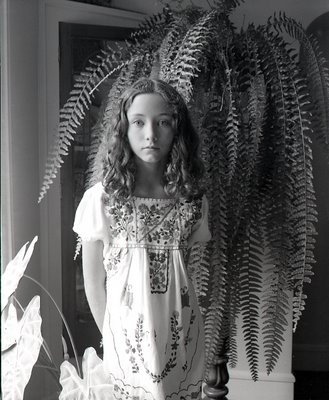
While I don't shoot digital I can still take a roll of film, in this case a discontinued Agfa ISO 400 b+w film, shoot it, process it and scan it within an hour. Here are two of the pictures I took today.
La Santa Muerte Smiles & I Don't Forget
Friday, August 22, 2008
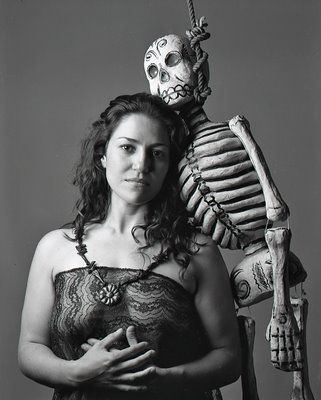
Jorge Wenceslao de Irureta Goyena and his first cousin Jorge Alejandro Waterhouse-Hayward were 8. We were riding a bus to Quilmes in the outskirts of Buenos Aires and Wency's father, My uncle Tony, told us with a smile, as our bus rounded a cemetery, "Someday I will lie there and you will come to visit me and everything will be just like today. You will remember." I never forgot. My Uncle Tony died in North Carolina. I don't know where he is buried. Wency disappeared from my life. He never left an impression with Google. But I do remember that day as our bus circled the cementerio. Strange how the spanish word for cemetery is closer to the idea that cement might just protect the body from decay. What nonsense!
In the late 60s my grandmother Lolita died in Mexico City. Uncle Tony came to the city for the services. His sisters, my mother Filomena and my aunt Dolly, took care of the preparations because Uncle Tony took me in search of his Holy Grail. At a bank he had seen a large golden cage with a stuffed parrot. He wanted a cage just like that. We went all over the city lookin for that golden cage. People talked (in low voices) of the strange man who did not seem to grieve for his mother. I was confused yet Uncle Tony was no different from that other day those many years ago when our bus was rounding the cemetery in Quilmes and with a smile on his face he had told us that one day we would visit him. That day was the first day I met up with the idea of death. I will never forget. At the end of our life all that remains is that some might just remember us for a while and a few, just a few, might go out and celebrate life by looking for an impossible golden cage.
Olvidos
He visto olvidos de todos tamaños
al pie de las cosas,
más largos que sombras.
Olvidos junto al árbol que corre
y junto al río que crece,
olvidos en las manos que aprietan
los senos que huyen presentes;
olvidos que salen a nuestro encuentro
en forma de encuentros
y pequeños silencios.
He visto olvidos antes del sueño,
y olvidos sobre olvidos
en el movimiento amoroso.
Yo he hecho una vida de olvidos,
una obra de olvidos.
El día que me muera
no será el día de mi muerte,
será el día de mi olvido.
El olvido de mi principio
se juntará al olvido de mi final.
Y todo, adentro y afuera de mí,
será olvido.
Ojos de otro mirar Selected Poems, Homero Aridjis, A New Directions Book, 2001 edited by Betty Farber and George Mc Whirter
Forgettings
I have seen forgettings in all sizes
at the foot of things,
even longer than their shadows.
Forgettings next to a tree that runs
and next to a river that grows,
forgettings in hands that tighten
around breasts that flee being there,
forgettings that come out
in the shape of bodies
and small silences to meet us.
Before sleep, I have seen forgettings
and in the movement of love
forgettings on top of forgettings.
I have made a life of forgettings,
a way of forgettings.
The day I die
won't be the day of my death,
it will be the day of my forgetting.
The forgetting of my beginning
will be joined to my ending's.
And all, within me and without,
will be a forgetting.
Eyes to See Otherwise Selected Poems, Homero Aridjis, Edited by Betty Farber and George McWhirter
Going through my collection of poetry of Homero Aridjis I conclude that if I were to be in a depressed mood I would call Aridjis the poet of death. But I remember his smile in the many times I have met him and I cannot be depressed even though so much of his poetry is about death. Note that the poem above is from a book that was edited by Aridjis's wife and his friend George McWhirter. Those who know might then know that Belfast born George McWhirter is Vancouver's Poet Laureate.
Homero Aridjis
And not forgetting Russell's father
La Santa Muerte
Thursday, August 21, 2008
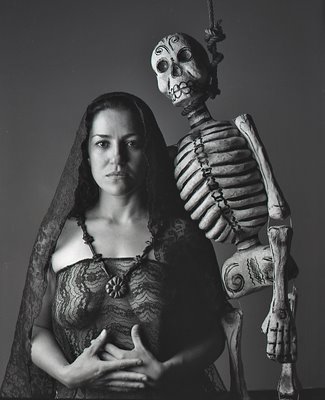
"La Santa Muerte" era el título de mi próximo artículo dominical. Karla Sánchez, una reportera de nuestro diario, había investigado la muerte de Jessica (así, sin apellido) a manos de La Flaca, una mujer bastante miserable con una sola capacidad: la de cometer un crimen horroroso en honor de la Santa Muerte. Con sus cómoplices Ojo Machucado, el Víbora y Cabeza de Piedra (fugitivos) había celebrado el asesinatoy desmembramiento de la dich Jessica en un cuartucho situado en el primer piso de un edificio nombre en un callejón anónimo de las orillas de una ciudad perdida. A los pies de una mesa que servía de altar se habían encontrado los despojos de la hoy occisa. Lado a lado, en un altar se habían colocado las imágenes de la Santa Muerte y de la Virgen de Guadalupe. El sincretismo de la Flaca saltaba a la vista al reunir bajo el mismo techo a la muerte azteca (representada por la Santa Muerte) y a la católica Virgen de Guadalupe. El altar estaba adornado por un cráneo humano, florero de vidrio rojo y cuchillos de carnicero. Velas rojas apagadas no lo alumbraban. A La Flaca se le halló acostada en un camastro rodeado de bolsas negras con basura, y con droga en una mesita de noche. En una hielera la cultista guardaba un camisón ensangrentado, vísceras humanas y una pantaleta (de Jessica)
Página 14 y 15, La Santa Muerte, Homero Aridjis 2003, Alfaguara
"La Santa Muerte" was the title of my next Sunday article. Karla Sánchez, a reporter of our newspaper had researched the death of Jessica (like that, without a surname) at the hands of La Flaca (the Skinny One). La Flaca was fairly miserable and she had but one skill which was to commit a horrible crime in honour of La Santa Muerte. With her accomplices Smashed Eye, The Snake and Stone Head (fugitives) she had celebrated the murder and dismemberment of the aforementioned Jessica in a hell hole of a room on the first floor of a building with no name in an anonymous back lane at the edge of a slum. Beneath a table that served as an altar, they had found remains of the victim. Side by side on the altar lay images of La Santa Muerte and the Virgin of Guadalupe. la Flaca's sincretism was astoudingly obvious as under one roof she had brought together Aztec death (represented by La Santa Muerte) and the Catholic Virgin of Guadalupe. The altar was adorned with a human skull, red glass vases and butcher knives. Unlit red candles did not light the scene. The Skinny One had been found lying on a cot surrounded by black bags full of garbage and drugs on a bed side table. The cultist had placed in a cooler a bloody dressing gown, human organs and a panty (Jessica's).
Page 14 and 15, La Santa Muerte, Homero Aridjis, 2003, Alfaguara, my translation.
-Oh,Santa Muerte, protégeme y líbrame de mis enemigos, embóscalos, tortúralos, enférmalos, mátalos, hazlos picadillo, Oh Santa Muerte, que dominas el mundo, en nombre de los que aquí están postrados, te pido poder conra mis adversarios. Que no me quiebren, que no me arresten, que no me maten. Te pido, Santa Muerte mía, que no me desampares ni de noche ni de día, y que me defiendas de la traición de amigos y enemigos. También te pido la muerte violenta de los que buscan mi mal. Llévatelos a la Casa Oscura donde tiritan de frío los muertos. Llévatelos a la Casa de los Murciélagos, donde chillan y revolotean los heridos de bala y bayoneta. Llévatelos a la Casa de las Navajas, donde rechinan las armas blancas. Todo lo puedes tú, Santa Muerte, concédeme este favor. Amén.
Página 127-128 La Santa Muerte, Homero Aridjis, 2003, Alfaguara
Oh!, Santa Muerte, protect me and deliver me from my enemies, ambush them, torture them, make them sick, kill them, make them into mince meat. Oh! Santa Muerte, you who are in command over the world in name of those who kneel here before you, I ask you for power against my adversaries. That they do not break me, arrest me or kill me. I ask you, my Santa Muerte, that you do not abandon me night or day and that you defend me from the treason of my friends and enemies. I also ask for the violent death of those who seek to harm me. Take them to the Dark House where the dead tremble with cold. Take them to the House of Bats where those wounded by bullets and bayonets senselessly fly and scream. Take them to the House of Razors where blades and knives screech. You can do all this, Santa Muerte. Grant me this wish. Amen.
Page 127-128 La Santa Muerte, Homero Aridjis, 2003, Alfaguara , my translation.
Mexican poet and novelist Homero Arijdis has been writing about (in several excellent novels and books of poetry) the "sincretismo" or the ability of the Mexican aboriginal to combine and meld the ancient gods of the Aztecs, Toltecs, Maya, etc with the God of the conquering Spaniards to form a curious and interesting blend of beliefs, superstition and wisdom that is unique in our modern world. In his book La Santa Muerte he tells of the La Santa Muerte (a most feminine Saint Death) who is venerated by drug lords and their gang members.
Before the book was published in 2003 I received and email from Aridjis's wife Betty, informing me with much excitement about this book. She was right about her excitement as the book left in me a lasting impression. When my friend Abraham Rogatnick (86) who seems to be preparing for his death by getting rid of all his stuff gave me his 48-year-old Mexican papier-mâché skeleton I knew I somehow had a project. Ms Hernandez agreed and here she is a most beautiful but scary Santa Muerte. I told Abraham about it and he was delighted.
El Evangelista In The Fraser Institute Tie
Wednesday, August 20, 2008
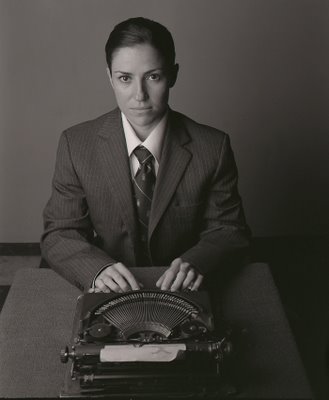
evangelista.(Del lat. evangelista).
1. m. Cada uno de los cuatro discípulos de Jesús con cuyo nombre se designa uno de los cuatro Evangelios.
2. m. Persona destinada a cantar el evangelio en las iglesias.
3. m. Méx. Hombre que tiene por oficio escribir cartas u otros papeles a la gente que no sabe hacerlo.
Real Academia Española © Todos los derechos reservados
Your ordinary poor Mexican may not have any idea who Cyrano de Bergerac is as many (at least in my time in the 50s, 60s and 70s) did not know how to read or write. This did not prevent them from writing love letters, letters of condolence, letters to government bureaucracy or perhaps attempting to find a job with a nice and neat application letter. Cyrano's job was performed and perhaps even today by men (they were always men) called evangelistas. An evangelio (or gospel) is a letter. Evangelistas are the scribes of the populace. They set up shop under portales (long arched sidewalks in the centre of Mexican cities) with a typewriter (usually ancient) and paper. For a fee they will strive to please.
Rosemary has informed me that we used the services of an evangelista once for some sort of government petition re our house and we did not know the legal language to use. Our evangelista had no problem making a one sentence request occupy a whole page. Our request was granted.
Here Ms Hernandez is posing with my pinstriped suit which I purchased at the Puerto de Liverpool (sort of like Eaton's) sometime in 1972. Her tie, a Fraser Institute tie, (why not?) was given to me by a friend who worked for the institute. I tried to explain to Ms Hernandez what the Fraser Institute was but in the end I gave up.
That Linhof & Sipping Fanta On A Mexican Beach
Tuesday, August 19, 2008

I went to Beau Photo today. It is the only photo equipment and supply store that routinely stocks the Ektachrome 100G in 120 which is what I use to take photographs in colour. Sooner or later when that film and or labs in Vancouver stop processing I will have to purchase a digital camera for my commercial work. I will still shoot Ektachrome or whatever other film replaces it and I will have it processed in Toronto or New York. When it becomes impossible it is my hope that by then I will have been vaporized in some lucky accident and my widow will be sipping Fanta on a Mexican beach.
While in Beau Photo I went from the film, paper and other stuff side of the store to the photo equipment and studio lighting side of the store. With my bag of film ($300 worth) I stared at all the lighting stuff that makes what I use look like a Studebaker Scotsman (this Studebaker tried to bring the idea of frugality and it sported no chrome. The idea was ahead of its time so the car failed).
An elderly man (I guess if I looked at myself in a mirror I would define myself as one) was getting rid of all his ancient gear. There were a couple of nice looking Pentacon Six 6x6cm cameras, one Mamiya RB-ProS like mine with two lenses, some sort of 4x5 inch field camera and a 6x6cm slide projector that looked like it had bored audiences for many years. The man looked at me and with a smile he said, "I am selling my stuff, I am downsizing and moving to an apartment. You know how it is?" I had to tell him that his Pentacon Sixes were dogs that had been made by reluctant German engineers in the Russian Occupied Zone of Germany and later by the same engineers, turned lazy bureaucrats of East Germany in the fine city of Dresden. "They have their peculiarties but as long as you know what they are the cameras work just fine." Whe he told me that, I countered with, "These were built before Germans started making good Audis." I did not remind him that the predecessors of Audi at that time were making DKWs that had a three cylinder engine that sounded like eggs frying in deep fat. But I admired his 140mm Mamiya lens with a floating lens element (I own two of these extremely sharp lenses). He smiled at me more generously. When he left with his receipt, what he had last told me reverberated in my head, "If they offer me too little I will take them back and give them away."
About four years ago I went to MCL Motorcars to photograph a man who managed the exotic automobile section of the company. I admired a beautiful dark blue Aston Martin. The man, an Englishman, barely smiled under his moustache and then sadly told me, "Don't look under the hood, it's a Ford."
Every once in a while when I am using my Nikon FM-2 which are nicely finished in metal and make satisfying clicks I think of where they came from. I think of the exotic Contax of the 1930s (more desirable to me than a Leica) and how that kind of machine work and fine manufacturing is all but dead. My German repairman, Horst Wenzel fixes mechanical cameras and restores them. He was trained at the Hasselblad plant and instinctively knows how mechanical cameras work. But he will not look at the latest crop of cameras. You need computers to access information on where and how to repair them. You have to be an electronics wizard. You have to be so specialized that you might be able to look into the latest Nikon but not the Canon.
I cannot believe that somehow the Germans started all this with their people's car, the VW Beetle. By early 70s my Mexican VW repair facility in Mexico City would plug into my car and check on a computer the compression of the engine. I was given the readout and told that my engine was in good shape at 90%.
I remember going to McQueen Sales (the Canadian representative of Asahi Pentax) in the early 80s with a Pentax ME Super that had failed me at a job. Kas, the consumate Japanese technician told me, "We have a new improved circuit board for it." The folks at Pentax in Vancouver had knewn beforehand that I had a camera with a faulty circuit board and had not bothered to call me. When Horst repairs my mechanical cameras I can expect them to work well for a long time.
When the sad man at Beau Photo showed me his 6x6 slide projector, I had to point out that I own a 6x7cm Linhof slide projector with Leica lenses (not an Aston Martin with a Ford engine). I can project my 6x7cm Ektachromes and fill the Orpheum stage wall if given the chance. The projector is manual and I have to put each slide, one at a time and shift the beautifully made slide holder seen here. It is solid metal and it makes a satisfying clunk if you slide it with spirit. If you don't the projector makes no sound and the cooling fan is not audible.
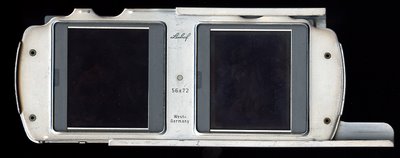
As I teach at Focal Point and I have to maneuver the operation of digital slide projectors (the images they project are of doubtful quality) I realize that an era has gone by. Cameras, people tell me, are efficient tools. They make (or capture images). I would not even begin to explain to them how I love my cameras and that they are more than just efficient tools. How can I tell them that I like to look at the nicks of imperfection or the effects of my hard use? They are my friends and companions of something I love to do. I take pictures, I don't capture pictures. The first implies a gentle cooperation with my subjects and with my cameras while the second seems almost aggresively violent.
It can only be a short time when I will probably take the plunge made by that old man and downsize, too. I don't look forward to it. Vaporization sounds like a better idea. Will I go alone or in the company of my friends?
A White Ghost At UBC
Monday, August 18, 2008

The 1956-1957 Lincoln Continental Mark II was the mid-'50s successor to the original Continental of the '40s. It was magnificently styled by a team including John Reinhart, William Clay Ford, and Gordon Buehrig. Engineer Harley Copp's unique "cowbelly" frame dipped low to permit high seating without a tall body.
With Multi-Drive three-speed automatic and a balanced, individually tested Lincoln V-8, the Mark II was marketed as an image leader intended to steal Cadillac's thunder in the ultra-luxury class.
Despite beautiful styling, it didn't sell well, probably because its price was so close to the (then) breathtaking $10,000 mark.
Last Thursday Rebecca, Graham Walker, Abraham Rogatnick and I went to UBC to the Chan Centre to listen to Rameau's Pygmalion presented by Early Music Vancouver. We picked up Rogatnick on our way. He lives on 11th Avenue and Trimble. We then proceded by Chancellor Boulevard. I have always been confused since it is similar (at the tail end near UBC) to University Boulevard. At one time what looked like a stately American antebellum mansion sat at the end. It is gone and there is a lot of construction of what looks like luxury condonminiums.

It was in front of that mansion that I photographed sometime around 1977 the most beautiful car in the world. It was an 1966-67 Lincoln Continental Mark II and its owner had hired me to take pictures of it. Little did he know that I knew little of this. I managed to overlook the rule that cars should be photographed free of distortion. I even (cringe) used a star filter to put stars on the headlights.
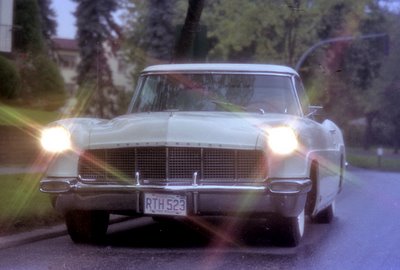
But I remember the mansion and the automobile fondly. I found the colour negatives in my files and had to use the colour restoration device of my scanner as those colour negatives had deteriorated with time. Even now that car seems to be a beautiful ghost with an existence all of its own.
Sunday, August 17, 2008
"Mental prayer [oración mental] is nothing else than a close sharing between friends; it means taking time frequently to be alone with him who we know loves us."
Santa Teresa de Jesús (St Teresa of Ávila)

Several events today made me suddenly turn into thinking about religion. At least in the sense that I want to write about it without in any way wishing to rant, nor is it my intention to proselytize.
I talked to my godmother (and first cousin) Inesita on Skype today. She is 86 and lives in Buenos Aires. She was visiting her son Georgito with whom I have been close since we independently served in the army (he) and the navy (me) in 1965. We talked and looked at each other for close to two hours. We talked about old age pensions (he is 64, I am about to be 66). In the end our conversation had to terminate because he was going to Sunday Mass. He made the comment (wrong one) that my last time at church was probably after my first communion. He was wrong, after all I went to a Catholic boarding school (high school) for four years.
It was at St Edward's High School that Brother Edwin Reggio C.S.C. taught me that perhaps the most important sacrament is that of confirmation. Confirmation, Brother Edwin had told us, made us soldiers of Christ. It made us defenders of our faith. It made us defenders (not in any agressive way) in being able to explain doctrine and our beliefs with clarity to those who might want to know.
I remember returning from my military service in Buenos Aires to Mexico and somehow ending up at Sunday Mass in a church not far from my Tia Fermina's. The service was odd to me in many ways. I had grown up with the classical Latin Mass. In this Mexican church the priest was facing us and speaking to us in Spanish. I understood somehow that Pope John XXIII and the Second Vatican Council were responsible for this strange turn of events at Mass. At one point during the service, the people by my side (I did not know them from Adam) suddenly embraced me. I was confused but they explained to me that this was the people's Mass and that's how things were done. My further but infrequent journeys into Catholic Mass services became mandatory funerals and the odd wedding. Sunday Mass was as dead to me as that April 8, 1966 Time Magazine cover, Is God Dead?
But it has been very difficult to let go. Consider that when I was 8, 9 and 10 my grandmother came to visit us to our Coghlan house in Buenos Aires on Good Friday. I was brought in from playing with my Jewish friend (Mario Hertzberg) out in the street and told to kneel in the living room. The time was somewhere around 3 in the afternoon when my grandmother asserted our Lord had died. She often would say that my friend Mario's ancestors, the Jews, had cruelly crucified our Lord. She would then lead us to recite the last words of Christ. The day was ever more depressing as I was told that we could not listen to any music.
It was about this time (1952, 1953) that Father Filippo informed us that if we did not become followers of Perón we would roast in hell.
In the mid 50s my mother was stricken by a terrible disease (it can be controlled now but it is still incurable) called Meniere's. This disease attacked the inner ear. It began with a buzz that got louder and louder. It was constant and it came with terrible attacks of nausea. My mother would just fall and would spend hours in bed holding on for dear life. Eventually the buzz and the disease destroyed her sense of balance and made her deaf even though the buzz never went away. By 1972 she was telling me that she wanted to die. One very terrible day she confessed to me that she had lost her belief in the power of prayer. "I do believe in God, " she told me, "but I don't believe in a God who cares about us. He is up there somewhere and is detached from human existence. We must really think we are important that He would want to listen to each one of us." And she died and Rosemary and I listened as she breathed in and never did exhale.
All the above went through my head today. Hilary lent us her copy of Milos Forman's Goya's Ghost. I know my Spanish history and I did note a few innacuracies of time compression, but the film was horrific in its display of the power of the Inquisition and the Catholic Church as the 18th century waned.
Having studied theology in school I understood the events of the film. The situation with the so called "trials" of the Inquisition have the also horrific parallel with those of the contemporary detention camps for terrorists in our Western world. We have simply not changed even if we do embrace at Mass.
Rebecca has seen this film and I wonder how at age 11 (today, happy birthday Rebecca) she can possibly understand all the complexities and intricacies of this disturbing film. Would she smile (no)? Or gasp in horror (no)? when my grandmother would point at some man with a large nose and say in her Castilian Spanish, "That man has the map of Jerusalem on his face."
I have mentioned here of my admiration for Graham Greene and of his novels of flawed protagonists who would lose their faith. In some small way this man (me) a product of the Latin Mass who was shockingly modernized with an embrace (not quite on the Concorde) has lost his way.
I look longingly at this photograph of my mother's first communion in New York City in 1920. Here, too is her rosary (of pressed rose petals) and dedicated to St Teresa of Ávila. Will I ever know which of them was right?

The spanish word for mirror is espejo. Espejismo is Spanish for mirage. I like espejo so much more. It is close to the original meaning in Latin, speculum which was mirror but specially a mirror in the water. A true espejismo in Spanish defines the term as an image that is upside down. In pre-columbian Mexico the word for mirror was obsidian since this was the only readily available surface that could act as a mirror. Gold and silver were far too precious for the ordinary Aztec. I like the idea of an obsidian mirror. Its darkness would colour the image in mysterious magic. After all trying to figure out our relationship with our image in a mirror is jus that.
Since I purchased a large and beautiful wooden framed mirror at Ikea I have become nearly obsessed with taking portraits with it. From self-portraits to photographs of my subjects looking at themselves into a mirror. Dancers and actors are so used to this that I am able to easily have them forget I am in the room. In my classes at Focal Point (the school purchased the Ikea mirror at my urging) I have my students go through their paces with the mirror. They soon find out it is far easier not to include oneself in the photograph than not. And if the mirror is positioned away from the wall it can be easily lit.
Last week when I started my Mexican nostalgia project with Ms. Hernandez she indicated she wanted a mirror show with me in it. Here it is.

Of late I have been overcome by moments of pure Mexican nostalgia. We eat a lot of Mexican food at home. This is Mexican food that I cook. One of my family's favourite is my Mexican rice. The secret to Mexican rice is that you have to fry it first and then add chicken broth. Rosemary loves to have yesterday's Mexican rice with fried eggs today. Both Rebecca and Hilary are a bit more daring than Rosemary so I have to make two hot sauces. One has tomatoes, cilantro a bit of surgar, Maldon salt and some fresh squeezed lime juice. To the second sauce I add several serrano peppers. This recipe was given to me by my Mexican/American friend, Robert Hijar who lives in Memphis. He insists that good Mexican salsa never has onion.
My Mexican nostalgia has been peppered on the side by the presence of my new Mexican model, Ms. Hernandez. I a couple of previous blogs I have shown pictures of her. Here is one in colour with some old fashioned Hollywood lighting. I used a metal stamped gobo for the cloud background and my mother's 1953 red sarape. While it was around 26 in my studio it was not hot enough to evoke the brilliant hot light of Mexico. I rarely used a high spot but here it almost brings to me an idea of that heat and light that I long for. Tonight as I lie in bed without covers and not much else the heat will remind me of Mexico and the smell of the tropics of my life in Veracruz or the dry desert heat of my Nueva Rosita, Coahuila days.
This photograph has a bit of John Ford's (1947) The Fugitive , one of my favourite films of all time which was based on a Graham Greene story with the lovely Dolores del Río, Henry Fonda and Pedro Armendáriz.
In colour I can imagine del Río in red just like Ms Hernandez.

For most of my life while my mother was alive I had to listen to, "Nunca podrás saber porque nunca serás mamá," or "You will never know because you will never be a mother." It used to infuriate me and now (half jokingly) I assert to some women that I would like to eliminate mother's day as it is a gender specific holiday that should not be in our age of political correctness. Both father's and mother's day should be rolled into something inocuous like parenting day or procreation day.

Back then, I never had the idea to get back at my mother by telling her that she would never know because she would never be a father or (now) a grandfather.
I watch Rosemary talk to both our cats, the male Toby (her cat) and my female Plata. She and I both impose our ideas of what it is to be a female and a male on these cats. I am not too sure that Plata (who is most graceful) is any more feminine or less masculine than Toby.

But when I photograph Lauren at 6 (now) I am overwhelmed in such a pleasant way by the fact that she is a little girl who is a little girl and not a little boy. I would not know what to do with a little boy. Or at least I tell myself this. It is just lots of fun to dress Lauren up and photograph her in the garden in much the same way I have been doing with Rebecca. I discern some differences but they are all delightful nontheless.
In these pictures here I decided not to hide the fact that Lauren had fallen off a tree days before (she did not cry) and was taken to emergency (she did not cry) and instead of being stiched up she was glewed up! She is wearing the sailor dress I bought for Rebecca in Cancun some 5 years ago.
In the first picture Lauren is posing by our ornamental cherry tree with the English Rose, Rosa 'L.D. Braitwaite'. In the second she is holding Rosa 'The Fairy' and her toy leopard, Sparkle. In the third photograph she is sniffing the intoxication myrrh scented English Rose, Rosa 'Mary Webb'. This latter rose is not too generous in blooming. I may get three or four flowers in a season. But they are large, ever so perfumed and they remind me of very heavy whipping cream.

I have written about chocolate and specifically about Mexican chocolate here. Chocolate has been in my mind of late because in the evenings when I am in bed reading, Rosemary goes down to the kitchen and more often than not returns with a chocolate bar. Rosemary loves chocolate. She has a preference for the Mexican variety. A few weeks ago she and Hilary and the granddaughters went to Washington State shopping for shoes and Rosemary scored a box of Chocolate Carlos V. It used to be made by the very company Richardson Merrill which sometime in the 70s had bought out the Vick Chemical Company. Richardson Merrill made exquisite chocolates and Vick's Vaporub. That situation changed as most of the chocolate companies in Mexico were consolidated and are now owned by Nestlé. But Mexican chocolate still manages to retain that hint of cinnamon that makes it so Mexican.
So when Ms. Hernandez showed up at my studio yesterday with a molinillo I did the obvious. A molinillo is made of wood and is usually carved out of one piece of wood. It has rings which are carved out from the centre and they can twirl when you twirl the molinillo. Mexicans twirl the molinillo when they are making hot chocolate and it froths up very nicely. Served hot at merienda (the Mexican and Spanish equivalent of tea time) it is especially good with churros (batter fried and then sprinkled with sugar). It is bad manners not to dunk the churros into the chocolate. The word for dunking (which comes from soup in Spanish) is sopear.
So here is Ms Hernandez as the ultimate hot chocolate maker. One of the best Mexican brands is Chocolate La Abuelita (The Little Grandmother). Ms Hernandez is the young lady the little grandmother once was. Or at least how I imagine her in my frothy nostalgia for Mexican chocolate.

Happiness for me (or at the very least one of the forms of happiness) comes with a good model that I can photograph for a private project. As a commercial photographer (that I am), unless I also have a private and personal project going, my job could become predictable and humdrum. Imagine the happiness of not only finding one good model but of finding two! I have two projects in the works with two fantastic models. What makes my new models unusual is that both are good photographers in their own right. I have experienced this before with Patrice.
With Ms Hernandez, who hails from León, Guanajuato, Mexico I have finally found the perfect subject to continue on my project of nostalgia. I have done a whole series with Linda Lorenzo. Now I can continue with the subject except that it will be Mexican nostalgia.
The picture here is fresh from a hurried drying of the wet negative (I shoot film) in my darkroom. It represents the first of many nostalgias that Ms Hernandez and I will cook up in our colaboración. Since she is a photographer I thought she would manage to find a way of conveying my nostalgia for a camera that I purchased (used) at Foto Rudiger in Mexico City, on Avenida Venustiano Carranza, in 1963. It still works but I stopped using it professionally around 1985. It is an Asahi Pentax S-3 with a coupled CDS light meter which you can see here mounted on top of the camera. Even in 1964 the "professional" black finish had begun to rub off and expose the beautiful brass underneath. This camera unlike my Pentacon-F had that light meter and a Japanese innovation called the instant return mirror.
Before I bought this gem I had haunted the Monte de Piedad (the National Pawnshop) near the Zócalo (main square) in Mexico City. There I had admired the Mirandas, the Nikons, the Praktinas and Prakticas, the Edixas and the Exaktas and a slew of other brand names that are long gone. These jewels behind the glass screens were mostly overpriced and the men behind would look at me most seriously when I would enquire about holding them. I finally settled for that S-3 and I remember dealing with a kindly German man who spoke Spanish with almost no trace of an accent. Could it have been Mr. Rudiger himself?
That S-3 traveled to Argentina, Brazil and Europe with me. I can and could make shutter and f-stop settings without looking. My S-3 became part of me. Seeing in Ms Hernandez's hand and how she deftly wrapped the strap around her wrists brought joy to me this morning.
I look forward to many more Mexican nostalgias.
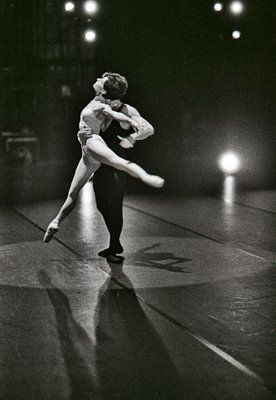
Every once in a while I find negatives I have never used for anything or even noticed. I feel that the Holy Grail of photography is to develop your own style. For many years my style did not put me in a favourable light, particularly with the high paying ad agencies of Vancouver. They didn't want an identifiable style. They wanted the blandness to be found in the modern picture that has a perfect white backgroun. People photographed with a perfect white backround in different cities by different photographers will look the same in a photo spread. The white background evens the playing field.
In our age of Flickr and facebook more and more pictures look the same. There are situations that do not lend themselves to helping the photographer develop a style. A very good example is studio photography of ballerinas and male dancers shot in the air in a large studio. We can enjoy the grace, the perfection of form but the photographer, unless named, will remain unknown. The same can be said of live rock concert pictures. Whether you get the singer without a microphone or with one the picture will look like millions of others.

Some years ago I was invited to shoot some rehearsal shots for Dancing on the Edge which that year was held at the Vancouver Playhouse. Nobody paid me a cent but I had access to any area back stage. With some very fast b+w film I shot some pictures. It was not easy but I managed a few photographs. You can see three here. They are Ballet BC dancers. These pictures could have been taken by anybody and if I had not seen them in my files I would have never guessed that I was the photographer. They have no style. They simply record.
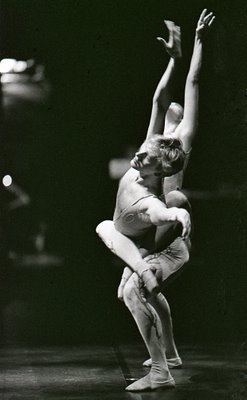
I prefer to have my dancers in my studio and to photograph them in portrait situations. These three photographs bore me but I do remember with excitement an event that day that I will never forget. I left the Playhouse for lunch and when I came back (via the back door that is entry point for both the Playhouse and the Queen Elizabeth Theatre) I turned left instead of right. But everything looked much the same. I ran into a man holding a guitar back stage and when I recognized him I realized my wrong turn. "What are you doing here?" Lou Reed asked me. I quickly apologized and made my exit.
That evening when I watched the opening night performance of Dancing On The Edge I could hear Sweet Jane next door.
The dancer whose face you see in the bottom is Miroslav Zydowicz my favourite male dancer ever from Ballet BC. There is more of him here. I decided to make my blog a dancing one tonight as I returned from my studio after a very pleasant session with three Arts Umbrella dancers. Artemis Gordon preened them and fussed over them and we all had a great time.
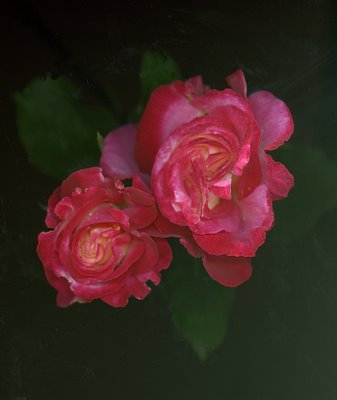
Dictionary writers are not kind to flummery. The innocent pudding is referred to as “bland custard” and “a sort of pap.” Webster’s says an alternative meaning is “Something insipid, or not worth having.”
The dish has had a number of incarnations — many of them insipid — but those lexicographers have obviously never tasted raspberry flummery, which is more pop than pap. It is made by gently breaking down the fragile berries with heat and sugar, fortifying them with a little cornstarch and then drenching the pudding with cool, fresh cream at the table.
When I read the above in the New York Times Sunday Magazine some weeks ago I was dazzled by the sight of a white plate with a swirl of raspberry and cream. I cut it out.
A few days ago when we visited Clemen on Bowen Island she dispatched us with a large container of her fresh picked raspberries. I could not wait. Last night Rebecca and I went to the kitchen while Rosemary and Lauren entertained our dinner guests Paul and Amy.
The dessert was a success and the leftover became raspberry syrup for this morning's pancakes. I am instructed by Rebecca and Lauren to make pancakes when they sleep over.
On our breakfast table I had a couple of Rosa 'Double Delight' (1977, Herbert Swimm and O.L. Weeks) in a little vase. I had scanned them yesterday when I noticed the two blooms in my back lane rose hospital. I have discovered that rose bushes that look dead are not always so. I take them out of the ground in the spring and put them into a black plastic pot. With a combination of frequent watering and the lane's hot sun they often pull a Lazarus (Heb. Elʿāzār Eleazar "God (has) helped"). Double Delight did. In the best of cases it is a difficult hybrid tea to grow. Rosemary ( a snob ) has always considered the rose garish but I like the peppery/sweet/fresh scent. I have had a few generations of this rose in my garden and most succumb after a few years. This has been my first successful revival.
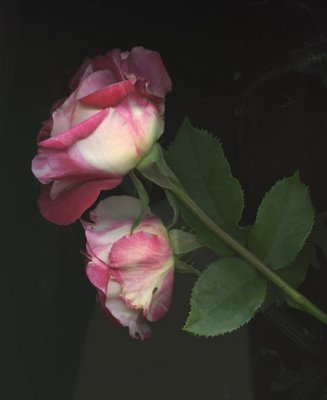
The usual description of Double Delight is, "A cream coloured rose that has been dipped into fresh raspberry jam." I asked Rebecca if two blooms of Double Delight would not be Double Delight twice over and she simply smiled and licked her lips.
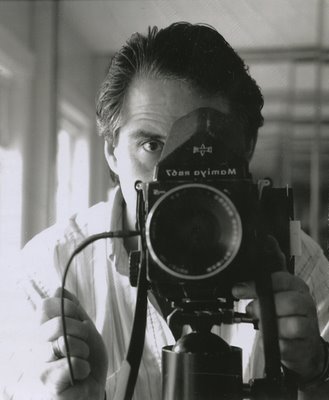
The term Who Shaves The Barber has appeared here recently and here.
It is not often that I find pictures of myself. Today Rosemary and I started putting some order to my files of family pictures since we were married 40 years ago. It was fun until we were overwhelmed and could not remember dates.
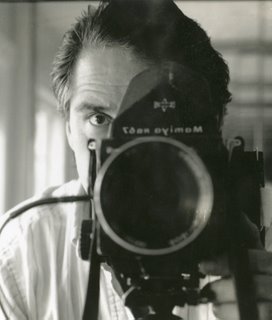
Luckily in many envelopes I had written either exact or approximate dates. I found an envelope that contained Polaroid instant black and white negatives with their corresponding prints. The date was July 17, 1991. Here are three.
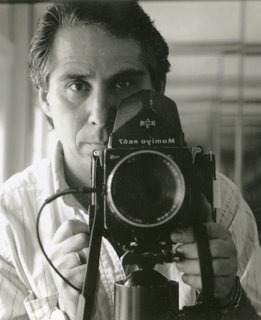

I often tell my students that the key to taking successful photographs is to have the technical side of it down pat so that one can concentrate on the interaction with one's subject. I rarely tell them that there has to be a good measure of extraordinary luck.
Hilary, during our visit with her Clemen, who came from Mexico to Vancouver in 1976 to take care of her and her sister Ale while Rosemary and I worked, used an expression that made me think. Hilary is modern and what she said was, "on the same page." I forget the context.
If I were to elaborate to my students I would tell them that once the photographic technique was mastered, one had to be on the same page with one's subject. But luck would still have to be the strong suit as here in this picture (below, right) of Rebecca which I took on July 24th, 2004. I attempted a re-make/sequel a couple of years later with the same rose (Rosa 'Mrs Oakley Fisher') and the little sailor dress I purchased at Sanborns in Cancun. There was no magic. And perhaps there is no magic in this further attempt which I took last week. The dress was much too small and it has been inherited by Lauren. For this shot Rebecca is wearing a Mexican dress given to her by her aunt Alexandra. Rosemary told me that she bought the dress originally for Ale when Ale was Rebecca's age but somehow she may have worn it only once.
Perhaps there was a newness in posing for me in 2004 that made Rebecca look at my camera in that startled and striking way. She is comfortable looking at me now. She sometimes groans when I ask her to pose.
As I look at this new picture I can see how Rebecca is growing. Will she soon stop climbing trees and carrying her cat Lilly everywhere? It won't be long when she will abandon her reading of Nancy Drew. Will it be possible that she will lose interest in picking up snakes and all kinds of bugs?

Yesterday we were all standing at a decaying pier on a pristine lake in the middle of Bowen Island. Rebecca looked at me and I said, "Jump in, you know how to swim well." Her mother had her doubts. Suddenly, a deer (with very large antlers), perhaps stalked by Clemen's pair of border collies came crashing by us (at first I thought it was a large brown dog) and jumped into the lake. This bit of magic was accompanied by my nod and Rebecca plunged into the lake, too.
Rebecca might grow up but I suspect that her daring sense of adventure will accompany her always.

"They are early this year, " some people say of this plant or that one. The fact is that most plants open on schedule unless an extra cold winter kills them. Our Casablanca lilies bloom every year around now and they are doing just that, now. A plant's schedule can be frustrating, almost sad. I will now have to wait until next June to see and smell my once blooming Rosa 'Charles de Mills'. Thankfully some roses persist and today (I write this on Wednesday afternoon) was able to take pictures with Lauren (with the slash on her forehead covered by a Hello Kitty band-aid) and Rosa 'The Fairy', Mary Webb and L.D. Braithwaite. Tune in on Friday or Saturday to see them.

The photographs of Rebecca with various hydrangeas that I took some days ago had to wait until today as the folks at G. King Photo ran out of nitrogen gas. Nitrogen is the inert gas used in the processing of my Ektachromes.
I had to wait from August 2004 to August 2008 to be able to display here the two pictures of Rebecca with Hydrangea macrophylly 'Blue Wave'. When I am am 70 I hope to be around to show similar shots of Lauren like the ones I took today with the very same plants. They are more likely to be around as they are mostly always on schedule.
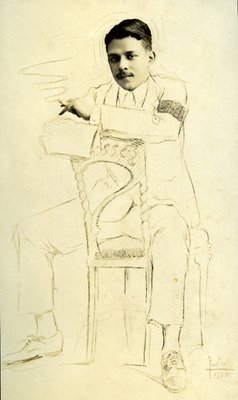
alféizar. (Del ár. hisp. *alḥáyza, y este del ár. clás. ḥā'izah, la que toma posesión).
1. m. Arq. Vuelta o derrame que hace la pared en el corte de una puerta o ventana, tanto por la parte de adentro como por la de afuera, dejando al descubierto el grueso del muro.
2. m. Arq. Rebajo en ángulo recto que forma el telar de una puerta o ventana con el derrame donde encajan las hojas de la puerta con que se cierra.
Real Academia Española © Todos los derechos reservados
One of the results of the Spanish American War (1898) that directly influenced my family on my mother's side who all lived in Manila is that the Philippines became an American protectorate. But it took a while as guerrilas fought the Americans in a pratracted and bloody insurgence. My grandfather Don Tirso de Irureta Goyena was a lawyer who in his short life (he died in his 30s of a heart attack shortly after climbing the beautiful volcano, Mayón) did everything to try to defend his beloved Spanish language from the encroachment of American English. But he did not loathe the Americans, just their language.
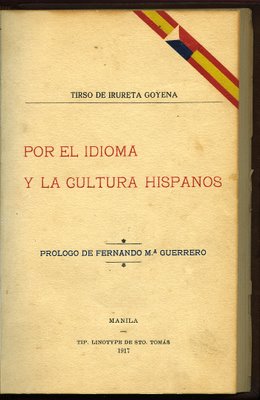
It seems that a particular American judge was his friend, my grandmother used to tell me. Civil proceedings at court were all held in English so my grandfather used a translator in his litigations. Many a time, my grandmother loved telling me, "Your grandfather would stop and tell the judge that the translator had it all wrong and that he had said something else. And then he would correct him." The judge would then smile at Tirso and say, "Tirso you speak perfect English, you don't need a translator. Let's stop this charade." His pleas were to no avail and Tirso gave lectures all over Manila and in Spain in defense of his beloved Spanish. He even wrote a book. His efforts were rewarded with membership (rare for a colonial or creole not born is Spain) in the Real Academia Española. For many years the huge diploma hung in my house over a wall in the picture seen here with my grandmother the day of my first communion. While in Mexico in the middle 70s my uncle Tony (Tirso's son) took the diploma over my protest and I never saw it again.

Last night I began Carlos Ruiz Zafón's El Juego del Ángel . Like his other novels and in particular La Sombra del Viento it is set in early 20th century Barcelona. His books are easy to read but I take longer than usual to read them because I savour his use of the Spanish language. A word, which means window sill in English, alféizar caught my eye. I began to dream on how the word came into the Spanish and wondered if my grandfather would have used it or noticed its beautiful sound. After all ojalá which is the word we voice to mean I hope comes from the Arabic and it means if Allah wills.

As Rosemary and I worked in the garden we talked about the sadness of taking care of a garden after a couple of open gardens (the Ballet BC Home & Garden and the Vancouver Rose Society). If we had a large family the family would come and we would have garden parties. But we are lucky that Rebecca, Lauren and their mother Hilary do come on Saturdays. While the little girls are interested in the garden, Hilary sees it in much the same way I would a row of used office furniture. Rebecca brings the rose catalogue/manual I gave her and she is interested in my roses and in hers. There is some passion there. But when Rosemary and I are alone in the garden removing the collapsed plants of late summer there is little joy. We are already looking at plants that have to be moved or plants that we have to get rid of (a tough thing it is).
While pruning I noticed the interesting galls in one of our two Rosa glaucas. Of this rose I wrote here. I was telling Rosemary that in a garden with little room left there is no need to have two of them. One is in her perennial bed and the second one (a very large specimen) by the boulevard where it thrives in spite of the shade. It is this second specimen that has the galls. This time around I was determined to find out exactly what they were. The gall wasp or Diplodepsis rosae is the culprit. I have scanned one of the more interesting branches but I don't know if I am daring enough to cut them in half to see what is inside. Perhaps I can get Rebecca involved in this. She loves bugs. For more on the gall wasp read here. Or if lazy, the interesting stuff reads like this:
Gall wasps are in the family Cynipidae, order Hymenoptera, class Insecta, phylum Arthropoda.
Gall wasps are small (only a few millimetres long), dark-coloured insect with a compressed abdomen. Most gall wasps form galls, though a few live within the galls formed by other species; these are called inquilines. Others feed on gall-formers and inquilines.
The exact reactions which lead to gall formation in the host plant are little understood. Basically it is a reaction of the cells of the plant to the presence of the larva.
Rose galls are produced by Diplolepis rosae. These gall wasps usually reproduce asexually; the females are about 4 mm/0.2 in long; parts of their abdomens and legs are yellow-red, while the rest of the body is black. Males of this species have been observed only rarely. The galls are a mass of reddish filaments within which are found a number of sealed chambers enclosing larvae. The larvae feed on the gall tissue.
© Research Machines plc 2005
What I found interesting is that the gall is not always occupied by the gall wasp but by other wasps and or insects called inquilines. In Spanish the word inquilinos is what you call renters who do not own the house they live in.

The beauty of the rose wasp gall is further enhanced at this time of the year by the large racemes of rose hips. Rosa glauca's hips may not be as large as those in other roses but they are certainly plentiful. While the ones here remind me of small tomatoes, as they age the colour begins to resemble the colour of a Hershey bar. An added bonus when I scanned the gall was the little gold point on the bottom right leaf. You can see it if you look closely at the first image. It enlarges if you click on the image. I further scanned that tip to reveal some sort of sucking insect. As to why the gall wasp "rents" the boulevard Rosa glauca, and no other roses in my garden I have no inkling.

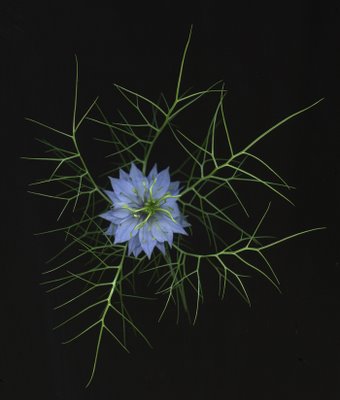
In years past Rosemary and I have seen many gardens in garden tours and conventions of the American Hosta Society. In the latter, in particular, the gardens have been "museum" gardens in which one genus (hosta) is featured with a few token companions. My friend W. George Schmid has no stomach for such a garden and neither do we. We stress the idea of companion plants. In some cases the companions can userp their role. Such is the case in one of my hosta beds where the ferns and astilbes now trumpet their delights at the expense of my hostas which are languishing in the shadows.
There is nothing worse than a true rose garden. A garden that is a monoculture with stacks and rows of roses. "The hybrid teas are here and Pemberton's Hybrid Musks there," the owner of such a garden might say. There is nothing worse than a museum garden that attempts to impart a further human logic of order.
In a spirit to prevent that very thing Rosemary has put energy for years in finding companions for our circular centre rose bed (it is the sunniest spot in our garden). Rosemary has succeeded with bronze fennel, Foeniculum vulgare 'Purpureum', assorted lavender and one of my favourite perennials that reminds me of Argentina. Verbena bonariense . This tall spindly plant has small blue flowers on the tips and they look good without trying to compete with my roses.
There is another plant that Rosemary loves and so do I. She sows the seeds of Nigella damascina 'Miss Jekyll' (not pink but a very striking blue) every spring and while this annual needs full sun it does not get it, relegated to the feet of my roses. But they manage to poke their little blue and frothy faces here and there to our delight.

Yesterday, Saturday the girls spent the day with us. Their mother, Hilary had dinner with us and we then all retired to see and enjoy Indiana Jones And The Last Crusade. I particularly enjoyed it as I had never seen it. During our viewing I experienced the pleasure of thinking about the day and the singular opportunity that we photographers get to experience the passing of time. Here you see a picture of Rebecca posing with Hydrangea macrophylla 'Blue Wave'. When we took the picture some five years ago she chose to cross her leg as she did. The photograph instantly disturbed my wife until I explained to her that Rebecca had wanted to look like her version of an adult. Since then countless pictures without her smiling have followed and the criticism from other memebers of the family have never stopped even if they have given up in trying to pursuade me to change my technique.
Lauren, unfortunately had an accident a few days ago. She fell from a tree and cut her forehead. Her other grandmother took her to emergency and her cut was "glued" together and a colourful band aid was put on. It seems that Lauren never did cry but I made the decision yesterday (I have since changed my mind) not to take her pictures with flowers and my large camera. She helped me by looking through the viewfinder (she stood on a bench) of my Mamiya. We photographed Rebecca with hydrangeas and in one case we attempted to mimic the one here. Those who are curious will have to wait until Tuesday when I will have the Ektachromes processed.
I was delighted that Rebecca showed interest in the hydrangeas and she particularly demanded I photograph her with Hydrangea aspera ssp. Villosa. She appreciated the curiuous purple colour and the primitive look of the flowers but quickly changed her mind when she posed for me. The flowers covered her with pollen that itched her skin and she almost cried and told me to hurry with the photographs.
There was one hydrangea I did not get to have time to photograph her with as by then she was through with me. This is the incredibly fascinating Hydrangea macrophylla 'Hanabi'. This is a Japanese cultivar and hanabi means fireworks in Japanese. I scanned a flower last night and the fertile flowers in the middle have yet to open. When they do the whole appearance of the inflorescence is of a burst of fireworks!

There is spotty information on this cultivar and the curious fact is that the best data on the plant comes from a local (Victoria) nursery called New Eden which specializes in:
Representing plant breeders from throughout the world who are involved in the breeding of woody plants, vines, perennials, conifers, and small trees.
These individuals are generally small operators of wholesale nurseries from throughout the world, the one thing they all have in common is that their efforts originated with the criteria in mind to enhance the home gardeners, gardening experience.
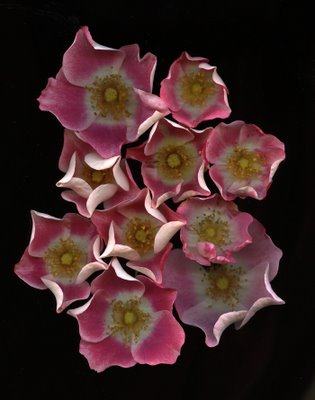
Sometimes I wonder about the French, after all they invented Champagne and the concept of high cousine. The French Meilland International Company grows some of the best roses in the world and have been doing it for at least 100 years. I would have never suspected that such a venerable company would invent the concept of roses to display in freeway medians. That's exactly what Meilland did. One of these roses, Rosa 'Pink Meidiland' never stops blooming in my garden. It never gets any diseases. It is a cast iron plant designed to survive in a city environment and thrive in spite of automobile emissions. My Pink Meidiland does not have much scent and this is perhaps its only flaw. But right now it is blooming and it is just about the only rose that is giving my cool hydrangeas (see yesterday's post) a run for their money.

While watching a baseball game in Mexico quite a few years ago (I may have been 15) there was a fly ball out and I heard the announcer call it a braguetazo. I thought about the word and smiled. A bragueta in Spanish is a man's fly. When some Mexican with either a sense of humour or a shaky command of English translated the term fly ball he did not opt to use the Spanish verb to fly which is volar. A braguetazo would loosely translate as a powerful swat with a man's fly! I will just add here that a left fielder in Mexican baseball parlance, jardinero izquierdo, translates as left gardener.
When learning English at an American School in Buenos Aires I was puzzled by many American terms including those from sports that were alien to me. One of my teachers kept using the term "life is a three ring circus". I had no concept of this. Circuses in Argentina were plentiful and all had only one ring in the middle. Why would anybody want to be distracted with more action? Particularly as my favourite circus came with a real boxing kangaroo.
Since I have no editor here the above will serve as a long-winded introduction for my love of hydrangeas at this time of the year. The remontant roses are having a well deserved rest. The once bloomers are growing long canes in preparation of new wood that will be next spring's old wood and source of my favourite gallica and alba blooms. My roses, even though they are spread about in the garden, somehow seem to be a one-ring circus. When they are around their beauty and their scent prevent me from noticing anything else. With them gone I look around as if I were in a three ringer and I notice all those dark corners and the wonderful deep blue hydrangeas with their clean, crisp and mostly serrated leaves. They are disease free and they don't have to be deadheaded. I must simply make sure they get adequate watering as they are the shrubs in the garden to suffer a drought.
Today, tired from my last 6-hour class (editorial photography) at Van Arts I walked around the garden with Lauren and I enjoyed the calming coolness of the blue hydranges. The bluest of them all is Hydrangea macrophylla 'Blaumaise'. It is a hydrangea developed in the 60s in Wädenswil, Switzerland and it is one of several called Teller series. It seems that teller is German for plate and the Germans and the Swiss do not call lacecaps, lacecaps. but plates! The Teller series are all named after German or Swiss birds so my very blue hydrangea is Blue Tit in English.
As I walk around, my head turns and I imagine I am in that three-ring circus I never saw but somehow the vision fades and I remember why Argentines call bad music, circus band music and that cute kangaroo that was the undefeated champion in my circus book of favourites.
"Mental prayer [oración mental] is nothing else than a close sharing between friends; it means taking time frequently to be alone with him who we know loves us."
Santa Teresa de Jesús (St Teresa of Ávila)

Several events today made me suddenly turn into thinking about religion. At least in the sense that I want to write about it without in any way wishing to rant, nor is it my intention to proselytize.
I talked to my godmother (and first cousin) Inesita on Skype today. She is 86 and lives in Buenos Aires. She was visiting her son Georgito with whom I have been close since we independently served in the army (he) and the navy (me) in 1965. We talked and looked at each other for close to two hours. We talked about old age pensions (he is 64, I am about to be 66). In the end our conversation had to terminate because he was going to Sunday Mass. He made the comment (wrong one) that my last time at church was probably after my first communion. He was wrong, after all I went to a Catholic boarding school (high school) for four years.
It was at St Edward's High School that Brother Edwin Reggio C.S.C. taught me that perhaps the most important sacrament is that of confirmation. Confirmation, Brother Edwin had told us, made us soldiers of Christ. It made us defenders of our faith. It made us defenders (not in any agressive way) in being able to explain doctrine and our beliefs with clarity to those who might want to know.
I remember returning from my military service in Buenos Aires to Mexico and somehow ending up at Sunday Mass in a church not far from my Tia Fermina's. The service was odd to me in many ways. I had grown up with the classical Latin Mass. In this Mexican church the priest was facing us and speaking to us in Spanish. I understood somehow that Pope John XXIII and the Second Vatican Council were responsible for this strange turn of events at Mass. At one point during the service, the people by my side (I did not know them from Adam) suddenly embraced me. I was confused but they explained to me that this was the people's Mass and that's how things were done. My further but infrequent journeys into Catholic Mass services became mandatory funerals and the odd wedding. Sunday Mass was as dead to me as that April 8, 1966 Time Magazine cover, Is God Dead?
But it has been very difficult to let go. Consider that when I was 8, 9 and 10 my grandmother came to visit us to our Coghlan house in Buenos Aires on Good Friday. I was brought in from playing with my Jewish friend (Mario Hertzberg) out in the street and told to kneel in the living room. The time was somewhere around 3 in the afternoon when my grandmother asserted our Lord had died. She often would say that my friend Mario's ancestors, the Jews, had cruelly crucified our Lord. She would then lead us to recite the last words of Christ. The day was ever more depressing as I was told that we could not listen to any music.
It was about this time (1952, 1953) that Father Filippo informed us that if we did not become followers of Perón we would roast in hell.
In the mid 50s my mother was stricken by a terrible disease (it can be controlled now but it is still incurable) called Meniere's. This disease attacked the inner ear. It began with a buzz that got louder and louder. It was constant and it came with terrible attacks of nausea. My mother would just fall and would spend hours in bed holding on for dear life. Eventually the buzz and the disease destroyed her sense of balance and made her deaf even though the buzz never went away. By 1972 she was telling me that she wanted to die. One very terrible day she confessed to me that she had lost her belief in the power of prayer. "I do believe in God, " she told me, "but I don't believe in a God who cares about us. He is up there somewhere and is detached from human existence. We must really think we are important that He would want to listen to each one of us." And she died and Rosemary and I listened as she breathed in and never did exhale.
All the above went through my head today. Hilary lent us her copy of Milos Forman's Goya's Ghost. I know my Spanish history and I did note a few innacuracies of time compression, but the film was horrific in its display of the power of the Inquisition and the Catholic Church as the 18th century waned.
Having studied theology in school I understood the events of the film. The situation with the so called "trials" of the Inquisition have the also horrific parallel with those of the contemporary detention camps for terrorists in our Western world. We have simply not changed even if we do embrace at Mass.
Rebecca has seen this film and I wonder how at age 11 (today, happy birthday Rebecca) she can possibly understand all the complexities and intricacies of this disturbing film. Would she smile (no)? Or gasp in horror (no)? when my grandmother would point at some man with a large nose and say in her Castilian Spanish, "That man has the map of Jerusalem on his face."
I have mentioned here of my admiration for Graham Greene and of his novels of flawed protagonists who would lose their faith. In some small way this man (me) a product of the Latin Mass who was shockingly modernized with an embrace (not quite on the Concorde) has lost his way.
I look longingly at this photograph of my mother's first communion in New York City in 1920. Here, too is her rosary (of pressed rose petals) and dedicated to St Teresa of Ávila. Will I ever know which of them was right?
That Ikea Mirror Into My Soul
Saturday, August 16, 2008

The spanish word for mirror is espejo. Espejismo is Spanish for mirage. I like espejo so much more. It is close to the original meaning in Latin, speculum which was mirror but specially a mirror in the water. A true espejismo in Spanish defines the term as an image that is upside down. In pre-columbian Mexico the word for mirror was obsidian since this was the only readily available surface that could act as a mirror. Gold and silver were far too precious for the ordinary Aztec. I like the idea of an obsidian mirror. Its darkness would colour the image in mysterious magic. After all trying to figure out our relationship with our image in a mirror is jus that.
Since I purchased a large and beautiful wooden framed mirror at Ikea I have become nearly obsessed with taking portraits with it. From self-portraits to photographs of my subjects looking at themselves into a mirror. Dancers and actors are so used to this that I am able to easily have them forget I am in the room. In my classes at Focal Point (the school purchased the Ikea mirror at my urging) I have my students go through their paces with the mirror. They soon find out it is far easier not to include oneself in the photograph than not. And if the mirror is positioned away from the wall it can be easily lit.
Last week when I started my Mexican nostalgia project with Ms. Hernandez she indicated she wanted a mirror show with me in it. Here it is.
Mexican Salsa & Dolores Del Río
Friday, August 15, 2008

Of late I have been overcome by moments of pure Mexican nostalgia. We eat a lot of Mexican food at home. This is Mexican food that I cook. One of my family's favourite is my Mexican rice. The secret to Mexican rice is that you have to fry it first and then add chicken broth. Rosemary loves to have yesterday's Mexican rice with fried eggs today. Both Rebecca and Hilary are a bit more daring than Rosemary so I have to make two hot sauces. One has tomatoes, cilantro a bit of surgar, Maldon salt and some fresh squeezed lime juice. To the second sauce I add several serrano peppers. This recipe was given to me by my Mexican/American friend, Robert Hijar who lives in Memphis. He insists that good Mexican salsa never has onion.
My Mexican nostalgia has been peppered on the side by the presence of my new Mexican model, Ms. Hernandez. I a couple of previous blogs I have shown pictures of her. Here is one in colour with some old fashioned Hollywood lighting. I used a metal stamped gobo for the cloud background and my mother's 1953 red sarape. While it was around 26 in my studio it was not hot enough to evoke the brilliant hot light of Mexico. I rarely used a high spot but here it almost brings to me an idea of that heat and light that I long for. Tonight as I lie in bed without covers and not much else the heat will remind me of Mexico and the smell of the tropics of my life in Veracruz or the dry desert heat of my Nueva Rosita, Coahuila days.
This photograph has a bit of John Ford's (1947) The Fugitive , one of my favourite films of all time which was based on a Graham Greene story with the lovely Dolores del Río, Henry Fonda and Pedro Armendáriz.
In colour I can imagine del Río in red just like Ms Hernandez.
Lauren, The Fairy & Sparkle The Leopard
Thursday, August 14, 2008
For most of my life while my mother was alive I had to listen to, "Nunca podrás saber porque nunca serás mamá," or "You will never know because you will never be a mother." It used to infuriate me and now (half jokingly) I assert to some women that I would like to eliminate mother's day as it is a gender specific holiday that should not be in our age of political correctness. Both father's and mother's day should be rolled into something inocuous like parenting day or procreation day.

Back then, I never had the idea to get back at my mother by telling her that she would never know because she would never be a father or (now) a grandfather.
I watch Rosemary talk to both our cats, the male Toby (her cat) and my female Plata. She and I both impose our ideas of what it is to be a female and a male on these cats. I am not too sure that Plata (who is most graceful) is any more feminine or less masculine than Toby.

But when I photograph Lauren at 6 (now) I am overwhelmed in such a pleasant way by the fact that she is a little girl who is a little girl and not a little boy. I would not know what to do with a little boy. Or at least I tell myself this. It is just lots of fun to dress Lauren up and photograph her in the garden in much the same way I have been doing with Rebecca. I discern some differences but they are all delightful nontheless.
In these pictures here I decided not to hide the fact that Lauren had fallen off a tree days before (she did not cry) and was taken to emergency (she did not cry) and instead of being stiched up she was glewed up! She is wearing the sailor dress I bought for Rebecca in Cancun some 5 years ago.
In the first picture Lauren is posing by our ornamental cherry tree with the English Rose, Rosa 'L.D. Braitwaite'. In the second she is holding Rosa 'The Fairy' and her toy leopard, Sparkle. In the third photograph she is sniffing the intoxication myrrh scented English Rose, Rosa 'Mary Webb'. This latter rose is not too generous in blooming. I may get three or four flowers in a season. But they are large, ever so perfumed and they remind me of very heavy whipping cream.
Nostalgia Mexicana - Chocolate
Wednesday, August 13, 2008

I have written about chocolate and specifically about Mexican chocolate here. Chocolate has been in my mind of late because in the evenings when I am in bed reading, Rosemary goes down to the kitchen and more often than not returns with a chocolate bar. Rosemary loves chocolate. She has a preference for the Mexican variety. A few weeks ago she and Hilary and the granddaughters went to Washington State shopping for shoes and Rosemary scored a box of Chocolate Carlos V. It used to be made by the very company Richardson Merrill which sometime in the 70s had bought out the Vick Chemical Company. Richardson Merrill made exquisite chocolates and Vick's Vaporub. That situation changed as most of the chocolate companies in Mexico were consolidated and are now owned by Nestlé. But Mexican chocolate still manages to retain that hint of cinnamon that makes it so Mexican.
So when Ms. Hernandez showed up at my studio yesterday with a molinillo I did the obvious. A molinillo is made of wood and is usually carved out of one piece of wood. It has rings which are carved out from the centre and they can twirl when you twirl the molinillo. Mexicans twirl the molinillo when they are making hot chocolate and it froths up very nicely. Served hot at merienda (the Mexican and Spanish equivalent of tea time) it is especially good with churros (batter fried and then sprinkled with sugar). It is bad manners not to dunk the churros into the chocolate. The word for dunking (which comes from soup in Spanish) is sopear.
So here is Ms Hernandez as the ultimate hot chocolate maker. One of the best Mexican brands is Chocolate La Abuelita (The Little Grandmother). Ms Hernandez is the young lady the little grandmother once was. Or at least how I imagine her in my frothy nostalgia for Mexican chocolate.
Nostalgia Mexicana - Foto Rudiger & The S-3
Tuesday, August 12, 2008

Happiness for me (or at the very least one of the forms of happiness) comes with a good model that I can photograph for a private project. As a commercial photographer (that I am), unless I also have a private and personal project going, my job could become predictable and humdrum. Imagine the happiness of not only finding one good model but of finding two! I have two projects in the works with two fantastic models. What makes my new models unusual is that both are good photographers in their own right. I have experienced this before with Patrice.
With Ms Hernandez, who hails from León, Guanajuato, Mexico I have finally found the perfect subject to continue on my project of nostalgia. I have done a whole series with Linda Lorenzo. Now I can continue with the subject except that it will be Mexican nostalgia.
The picture here is fresh from a hurried drying of the wet negative (I shoot film) in my darkroom. It represents the first of many nostalgias that Ms Hernandez and I will cook up in our colaboración. Since she is a photographer I thought she would manage to find a way of conveying my nostalgia for a camera that I purchased (used) at Foto Rudiger in Mexico City, on Avenida Venustiano Carranza, in 1963. It still works but I stopped using it professionally around 1985. It is an Asahi Pentax S-3 with a coupled CDS light meter which you can see here mounted on top of the camera. Even in 1964 the "professional" black finish had begun to rub off and expose the beautiful brass underneath. This camera unlike my Pentacon-F had that light meter and a Japanese innovation called the instant return mirror.
Before I bought this gem I had haunted the Monte de Piedad (the National Pawnshop) near the Zócalo (main square) in Mexico City. There I had admired the Mirandas, the Nikons, the Praktinas and Prakticas, the Edixas and the Exaktas and a slew of other brand names that are long gone. These jewels behind the glass screens were mostly overpriced and the men behind would look at me most seriously when I would enquire about holding them. I finally settled for that S-3 and I remember dealing with a kindly German man who spoke Spanish with almost no trace of an accent. Could it have been Mr. Rudiger himself?
That S-3 traveled to Argentina, Brazil and Europe with me. I can and could make shutter and f-stop settings without looking. My S-3 became part of me. Seeing in Ms Hernandez's hand and how she deftly wrapped the strap around her wrists brought joy to me this morning.
I look forward to many more Mexican nostalgias.
Dancing On The Edge With Lou Reed
Monday, August 11, 2008

Every once in a while I find negatives I have never used for anything or even noticed. I feel that the Holy Grail of photography is to develop your own style. For many years my style did not put me in a favourable light, particularly with the high paying ad agencies of Vancouver. They didn't want an identifiable style. They wanted the blandness to be found in the modern picture that has a perfect white backgroun. People photographed with a perfect white backround in different cities by different photographers will look the same in a photo spread. The white background evens the playing field.
In our age of Flickr and facebook more and more pictures look the same. There are situations that do not lend themselves to helping the photographer develop a style. A very good example is studio photography of ballerinas and male dancers shot in the air in a large studio. We can enjoy the grace, the perfection of form but the photographer, unless named, will remain unknown. The same can be said of live rock concert pictures. Whether you get the singer without a microphone or with one the picture will look like millions of others.

Some years ago I was invited to shoot some rehearsal shots for Dancing on the Edge which that year was held at the Vancouver Playhouse. Nobody paid me a cent but I had access to any area back stage. With some very fast b+w film I shot some pictures. It was not easy but I managed a few photographs. You can see three here. They are Ballet BC dancers. These pictures could have been taken by anybody and if I had not seen them in my files I would have never guessed that I was the photographer. They have no style. They simply record.

I prefer to have my dancers in my studio and to photograph them in portrait situations. These three photographs bore me but I do remember with excitement an event that day that I will never forget. I left the Playhouse for lunch and when I came back (via the back door that is entry point for both the Playhouse and the Queen Elizabeth Theatre) I turned left instead of right. But everything looked much the same. I ran into a man holding a guitar back stage and when I recognized him I realized my wrong turn. "What are you doing here?" Lou Reed asked me. I quickly apologized and made my exit.
That evening when I watched the opening night performance of Dancing On The Edge I could hear Sweet Jane next door.
The dancer whose face you see in the bottom is Miroslav Zydowicz my favourite male dancer ever from Ballet BC. There is more of him here. I decided to make my blog a dancing one tonight as I returned from my studio after a very pleasant session with three Arts Umbrella dancers. Artemis Gordon preened them and fussed over them and we all had a great time.
The Double Delight Of Raspberry Flummery
Sunday, August 10, 2008

Dictionary writers are not kind to flummery. The innocent pudding is referred to as “bland custard” and “a sort of pap.” Webster’s says an alternative meaning is “Something insipid, or not worth having.”
The dish has had a number of incarnations — many of them insipid — but those lexicographers have obviously never tasted raspberry flummery, which is more pop than pap. It is made by gently breaking down the fragile berries with heat and sugar, fortifying them with a little cornstarch and then drenching the pudding with cool, fresh cream at the table.
When I read the above in the New York Times Sunday Magazine some weeks ago I was dazzled by the sight of a white plate with a swirl of raspberry and cream. I cut it out.
A few days ago when we visited Clemen on Bowen Island she dispatched us with a large container of her fresh picked raspberries. I could not wait. Last night Rebecca and I went to the kitchen while Rosemary and Lauren entertained our dinner guests Paul and Amy.
The dessert was a success and the leftover became raspberry syrup for this morning's pancakes. I am instructed by Rebecca and Lauren to make pancakes when they sleep over.
On our breakfast table I had a couple of Rosa 'Double Delight' (1977, Herbert Swimm and O.L. Weeks) in a little vase. I had scanned them yesterday when I noticed the two blooms in my back lane rose hospital. I have discovered that rose bushes that look dead are not always so. I take them out of the ground in the spring and put them into a black plastic pot. With a combination of frequent watering and the lane's hot sun they often pull a Lazarus (Heb. Elʿāzār Eleazar "God (has) helped"). Double Delight did. In the best of cases it is a difficult hybrid tea to grow. Rosemary ( a snob ) has always considered the rose garish but I like the peppery/sweet/fresh scent. I have had a few generations of this rose in my garden and most succumb after a few years. This has been my first successful revival.

The usual description of Double Delight is, "A cream coloured rose that has been dipped into fresh raspberry jam." I asked Rebecca if two blooms of Double Delight would not be Double Delight twice over and she simply smiled and licked her lips.
Who Shaves The Barber Redux
Saturday, August 09, 2008

The term Who Shaves The Barber has appeared here recently and here.
It is not often that I find pictures of myself. Today Rosemary and I started putting some order to my files of family pictures since we were married 40 years ago. It was fun until we were overwhelmed and could not remember dates.

Luckily in many envelopes I had written either exact or approximate dates. I found an envelope that contained Polaroid instant black and white negatives with their corresponding prints. The date was July 17, 1991. Here are three.

A Daring Sense Of Adventure
Friday, August 08, 2008

I often tell my students that the key to taking successful photographs is to have the technical side of it down pat so that one can concentrate on the interaction with one's subject. I rarely tell them that there has to be a good measure of extraordinary luck.
Hilary, during our visit with her Clemen, who came from Mexico to Vancouver in 1976 to take care of her and her sister Ale while Rosemary and I worked, used an expression that made me think. Hilary is modern and what she said was, "on the same page." I forget the context.
If I were to elaborate to my students I would tell them that once the photographic technique was mastered, one had to be on the same page with one's subject. But luck would still have to be the strong suit as here in this picture (below, right) of Rebecca which I took on July 24th, 2004. I attempted a re-make/sequel a couple of years later with the same rose (Rosa 'Mrs Oakley Fisher') and the little sailor dress I purchased at Sanborns in Cancun. There was no magic. And perhaps there is no magic in this further attempt which I took last week. The dress was much too small and it has been inherited by Lauren. For this shot Rebecca is wearing a Mexican dress given to her by her aunt Alexandra. Rosemary told me that she bought the dress originally for Ale when Ale was Rebecca's age but somehow she may have worn it only once.
Perhaps there was a newness in posing for me in 2004 that made Rebecca look at my camera in that startled and striking way. She is comfortable looking at me now. She sometimes groans when I ask her to pose.
As I look at this new picture I can see how Rebecca is growing. Will she soon stop climbing trees and carrying her cat Lilly everywhere? It won't be long when she will abandon her reading of Nancy Drew. Will it be possible that she will lose interest in picking up snakes and all kinds of bugs?

Yesterday we were all standing at a decaying pier on a pristine lake in the middle of Bowen Island. Rebecca looked at me and I said, "Jump in, you know how to swim well." Her mother had her doubts. Suddenly, a deer (with very large antlers), perhaps stalked by Clemen's pair of border collies came crashing by us (at first I thought it was a large brown dog) and jumped into the lake. This bit of magic was accompanied by my nod and Rebecca plunged into the lake, too.
Rebecca might grow up but I suspect that her daring sense of adventure will accompany her always.
Hydrangea macrophylla 'Blue Wave' - On Schedule
Thursday, August 07, 2008

"They are early this year, " some people say of this plant or that one. The fact is that most plants open on schedule unless an extra cold winter kills them. Our Casablanca lilies bloom every year around now and they are doing just that, now. A plant's schedule can be frustrating, almost sad. I will now have to wait until next June to see and smell my once blooming Rosa 'Charles de Mills'. Thankfully some roses persist and today (I write this on Wednesday afternoon) was able to take pictures with Lauren (with the slash on her forehead covered by a Hello Kitty band-aid) and Rosa 'The Fairy', Mary Webb and L.D. Braithwaite. Tune in on Friday or Saturday to see them.

The photographs of Rebecca with various hydrangeas that I took some days ago had to wait until today as the folks at G. King Photo ran out of nitrogen gas. Nitrogen is the inert gas used in the processing of my Ektachromes.
I had to wait from August 2004 to August 2008 to be able to display here the two pictures of Rebecca with Hydrangea macrophylly 'Blue Wave'. When I am am 70 I hope to be around to show similar shots of Lauren like the ones I took today with the very same plants. They are more likely to be around as they are mostly always on schedule.
Spanish On My Window Sill
Wednesday, August 06, 2008

alféizar. (Del ár. hisp. *alḥáyza, y este del ár. clás. ḥā'izah, la que toma posesión).
1. m. Arq. Vuelta o derrame que hace la pared en el corte de una puerta o ventana, tanto por la parte de adentro como por la de afuera, dejando al descubierto el grueso del muro.
2. m. Arq. Rebajo en ángulo recto que forma el telar de una puerta o ventana con el derrame donde encajan las hojas de la puerta con que se cierra.
Real Academia Española © Todos los derechos reservados
One of the results of the Spanish American War (1898) that directly influenced my family on my mother's side who all lived in Manila is that the Philippines became an American protectorate. But it took a while as guerrilas fought the Americans in a pratracted and bloody insurgence. My grandfather Don Tirso de Irureta Goyena was a lawyer who in his short life (he died in his 30s of a heart attack shortly after climbing the beautiful volcano, Mayón) did everything to try to defend his beloved Spanish language from the encroachment of American English. But he did not loathe the Americans, just their language.

It seems that a particular American judge was his friend, my grandmother used to tell me. Civil proceedings at court were all held in English so my grandfather used a translator in his litigations. Many a time, my grandmother loved telling me, "Your grandfather would stop and tell the judge that the translator had it all wrong and that he had said something else. And then he would correct him." The judge would then smile at Tirso and say, "Tirso you speak perfect English, you don't need a translator. Let's stop this charade." His pleas were to no avail and Tirso gave lectures all over Manila and in Spain in defense of his beloved Spanish. He even wrote a book. His efforts were rewarded with membership (rare for a colonial or creole not born is Spain) in the Real Academia Española. For many years the huge diploma hung in my house over a wall in the picture seen here with my grandmother the day of my first communion. While in Mexico in the middle 70s my uncle Tony (Tirso's son) took the diploma over my protest and I never saw it again.

Last night I began Carlos Ruiz Zafón's El Juego del Ángel . Like his other novels and in particular La Sombra del Viento it is set in early 20th century Barcelona. His books are easy to read but I take longer than usual to read them because I savour his use of the Spanish language. A word, which means window sill in English, alféizar caught my eye. I began to dream on how the word came into the Spanish and wondered if my grandfather would have used it or noticed its beautiful sound. After all ojalá which is the word we voice to mean I hope comes from the Arabic and it means if Allah wills.
Diplolepis rosae
Tuesday, August 05, 2008

As Rosemary and I worked in the garden we talked about the sadness of taking care of a garden after a couple of open gardens (the Ballet BC Home & Garden and the Vancouver Rose Society). If we had a large family the family would come and we would have garden parties. But we are lucky that Rebecca, Lauren and their mother Hilary do come on Saturdays. While the little girls are interested in the garden, Hilary sees it in much the same way I would a row of used office furniture. Rebecca brings the rose catalogue/manual I gave her and she is interested in my roses and in hers. There is some passion there. But when Rosemary and I are alone in the garden removing the collapsed plants of late summer there is little joy. We are already looking at plants that have to be moved or plants that we have to get rid of (a tough thing it is).
While pruning I noticed the interesting galls in one of our two Rosa glaucas. Of this rose I wrote here. I was telling Rosemary that in a garden with little room left there is no need to have two of them. One is in her perennial bed and the second one (a very large specimen) by the boulevard where it thrives in spite of the shade. It is this second specimen that has the galls. This time around I was determined to find out exactly what they were. The gall wasp or Diplodepsis rosae is the culprit. I have scanned one of the more interesting branches but I don't know if I am daring enough to cut them in half to see what is inside. Perhaps I can get Rebecca involved in this. She loves bugs. For more on the gall wasp read here. Or if lazy, the interesting stuff reads like this:
Gall wasps are in the family Cynipidae, order Hymenoptera, class Insecta, phylum Arthropoda.
Gall wasps are small (only a few millimetres long), dark-coloured insect with a compressed abdomen. Most gall wasps form galls, though a few live within the galls formed by other species; these are called inquilines. Others feed on gall-formers and inquilines.
The exact reactions which lead to gall formation in the host plant are little understood. Basically it is a reaction of the cells of the plant to the presence of the larva.
Rose galls are produced by Diplolepis rosae. These gall wasps usually reproduce asexually; the females are about 4 mm/0.2 in long; parts of their abdomens and legs are yellow-red, while the rest of the body is black. Males of this species have been observed only rarely. The galls are a mass of reddish filaments within which are found a number of sealed chambers enclosing larvae. The larvae feed on the gall tissue.
© Research Machines plc 2005
What I found interesting is that the gall is not always occupied by the gall wasp but by other wasps and or insects called inquilines. In Spanish the word inquilinos is what you call renters who do not own the house they live in.

The beauty of the rose wasp gall is further enhanced at this time of the year by the large racemes of rose hips. Rosa glauca's hips may not be as large as those in other roses but they are certainly plentiful. While the ones here remind me of small tomatoes, as they age the colour begins to resemble the colour of a Hershey bar. An added bonus when I scanned the gall was the little gold point on the bottom right leaf. You can see it if you look closely at the first image. It enlarges if you click on the image. I further scanned that tip to reveal some sort of sucking insect. As to why the gall wasp "rents" the boulevard Rosa glauca, and no other roses in my garden I have no inkling.

Miss Jekyll Is A True Companion
Monday, August 04, 2008

In years past Rosemary and I have seen many gardens in garden tours and conventions of the American Hosta Society. In the latter, in particular, the gardens have been "museum" gardens in which one genus (hosta) is featured with a few token companions. My friend W. George Schmid has no stomach for such a garden and neither do we. We stress the idea of companion plants. In some cases the companions can userp their role. Such is the case in one of my hosta beds where the ferns and astilbes now trumpet their delights at the expense of my hostas which are languishing in the shadows.
There is nothing worse than a true rose garden. A garden that is a monoculture with stacks and rows of roses. "The hybrid teas are here and Pemberton's Hybrid Musks there," the owner of such a garden might say. There is nothing worse than a museum garden that attempts to impart a further human logic of order.
In a spirit to prevent that very thing Rosemary has put energy for years in finding companions for our circular centre rose bed (it is the sunniest spot in our garden). Rosemary has succeeded with bronze fennel, Foeniculum vulgare 'Purpureum', assorted lavender and one of my favourite perennials that reminds me of Argentina. Verbena bonariense . This tall spindly plant has small blue flowers on the tips and they look good without trying to compete with my roses.
There is another plant that Rosemary loves and so do I. She sows the seeds of Nigella damascina 'Miss Jekyll' (not pink but a very striking blue) every spring and while this annual needs full sun it does not get it, relegated to the feet of my roses. But they manage to poke their little blue and frothy faces here and there to our delight.
Floral Fireworks & Rebecca Appreciates Hydrangeas
Sunday, August 03, 2008

Yesterday, Saturday the girls spent the day with us. Their mother, Hilary had dinner with us and we then all retired to see and enjoy Indiana Jones And The Last Crusade. I particularly enjoyed it as I had never seen it. During our viewing I experienced the pleasure of thinking about the day and the singular opportunity that we photographers get to experience the passing of time. Here you see a picture of Rebecca posing with Hydrangea macrophylla 'Blue Wave'. When we took the picture some five years ago she chose to cross her leg as she did. The photograph instantly disturbed my wife until I explained to her that Rebecca had wanted to look like her version of an adult. Since then countless pictures without her smiling have followed and the criticism from other memebers of the family have never stopped even if they have given up in trying to pursuade me to change my technique.
Lauren, unfortunately had an accident a few days ago. She fell from a tree and cut her forehead. Her other grandmother took her to emergency and her cut was "glued" together and a colourful band aid was put on. It seems that Lauren never did cry but I made the decision yesterday (I have since changed my mind) not to take her pictures with flowers and my large camera. She helped me by looking through the viewfinder (she stood on a bench) of my Mamiya. We photographed Rebecca with hydrangeas and in one case we attempted to mimic the one here. Those who are curious will have to wait until Tuesday when I will have the Ektachromes processed.
I was delighted that Rebecca showed interest in the hydrangeas and she particularly demanded I photograph her with Hydrangea aspera ssp. Villosa. She appreciated the curiuous purple colour and the primitive look of the flowers but quickly changed her mind when she posed for me. The flowers covered her with pollen that itched her skin and she almost cried and told me to hurry with the photographs.
There was one hydrangea I did not get to have time to photograph her with as by then she was through with me. This is the incredibly fascinating Hydrangea macrophylla 'Hanabi'. This is a Japanese cultivar and hanabi means fireworks in Japanese. I scanned a flower last night and the fertile flowers in the middle have yet to open. When they do the whole appearance of the inflorescence is of a burst of fireworks!

There is spotty information on this cultivar and the curious fact is that the best data on the plant comes from a local (Victoria) nursery called New Eden which specializes in:
Representing plant breeders from throughout the world who are involved in the breeding of woody plants, vines, perennials, conifers, and small trees.
These individuals are generally small operators of wholesale nurseries from throughout the world, the one thing they all have in common is that their efforts originated with the criteria in mind to enhance the home gardeners, gardening experience.
Vin Ordinaire In My Garden
Saturday, August 02, 2008

Sometimes I wonder about the French, after all they invented Champagne and the concept of high cousine. The French Meilland International Company grows some of the best roses in the world and have been doing it for at least 100 years. I would have never suspected that such a venerable company would invent the concept of roses to display in freeway medians. That's exactly what Meilland did. One of these roses, Rosa 'Pink Meidiland' never stops blooming in my garden. It never gets any diseases. It is a cast iron plant designed to survive in a city environment and thrive in spite of automobile emissions. My Pink Meidiland does not have much scent and this is perhaps its only flaw. But right now it is blooming and it is just about the only rose that is giving my cool hydrangeas (see yesterday's post) a run for their money.
The Blue Tit & The Boxing Kangaroo
Friday, August 01, 2008

While watching a baseball game in Mexico quite a few years ago (I may have been 15) there was a fly ball out and I heard the announcer call it a braguetazo. I thought about the word and smiled. A bragueta in Spanish is a man's fly. When some Mexican with either a sense of humour or a shaky command of English translated the term fly ball he did not opt to use the Spanish verb to fly which is volar. A braguetazo would loosely translate as a powerful swat with a man's fly! I will just add here that a left fielder in Mexican baseball parlance, jardinero izquierdo, translates as left gardener.
When learning English at an American School in Buenos Aires I was puzzled by many American terms including those from sports that were alien to me. One of my teachers kept using the term "life is a three ring circus". I had no concept of this. Circuses in Argentina were plentiful and all had only one ring in the middle. Why would anybody want to be distracted with more action? Particularly as my favourite circus came with a real boxing kangaroo.
Since I have no editor here the above will serve as a long-winded introduction for my love of hydrangeas at this time of the year. The remontant roses are having a well deserved rest. The once bloomers are growing long canes in preparation of new wood that will be next spring's old wood and source of my favourite gallica and alba blooms. My roses, even though they are spread about in the garden, somehow seem to be a one-ring circus. When they are around their beauty and their scent prevent me from noticing anything else. With them gone I look around as if I were in a three ringer and I notice all those dark corners and the wonderful deep blue hydrangeas with their clean, crisp and mostly serrated leaves. They are disease free and they don't have to be deadheaded. I must simply make sure they get adequate watering as they are the shrubs in the garden to suffer a drought.
Today, tired from my last 6-hour class (editorial photography) at Van Arts I walked around the garden with Lauren and I enjoyed the calming coolness of the blue hydranges. The bluest of them all is Hydrangea macrophylla 'Blaumaise'. It is a hydrangea developed in the 60s in Wädenswil, Switzerland and it is one of several called Teller series. It seems that teller is German for plate and the Germans and the Swiss do not call lacecaps, lacecaps. but plates! The Teller series are all named after German or Swiss birds so my very blue hydrangea is Blue Tit in English.
As I walk around, my head turns and I imagine I am in that three-ring circus I never saw but somehow the vision fades and I remember why Argentines call bad music, circus band music and that cute kangaroo that was the undefeated champion in my circus book of favourites.






